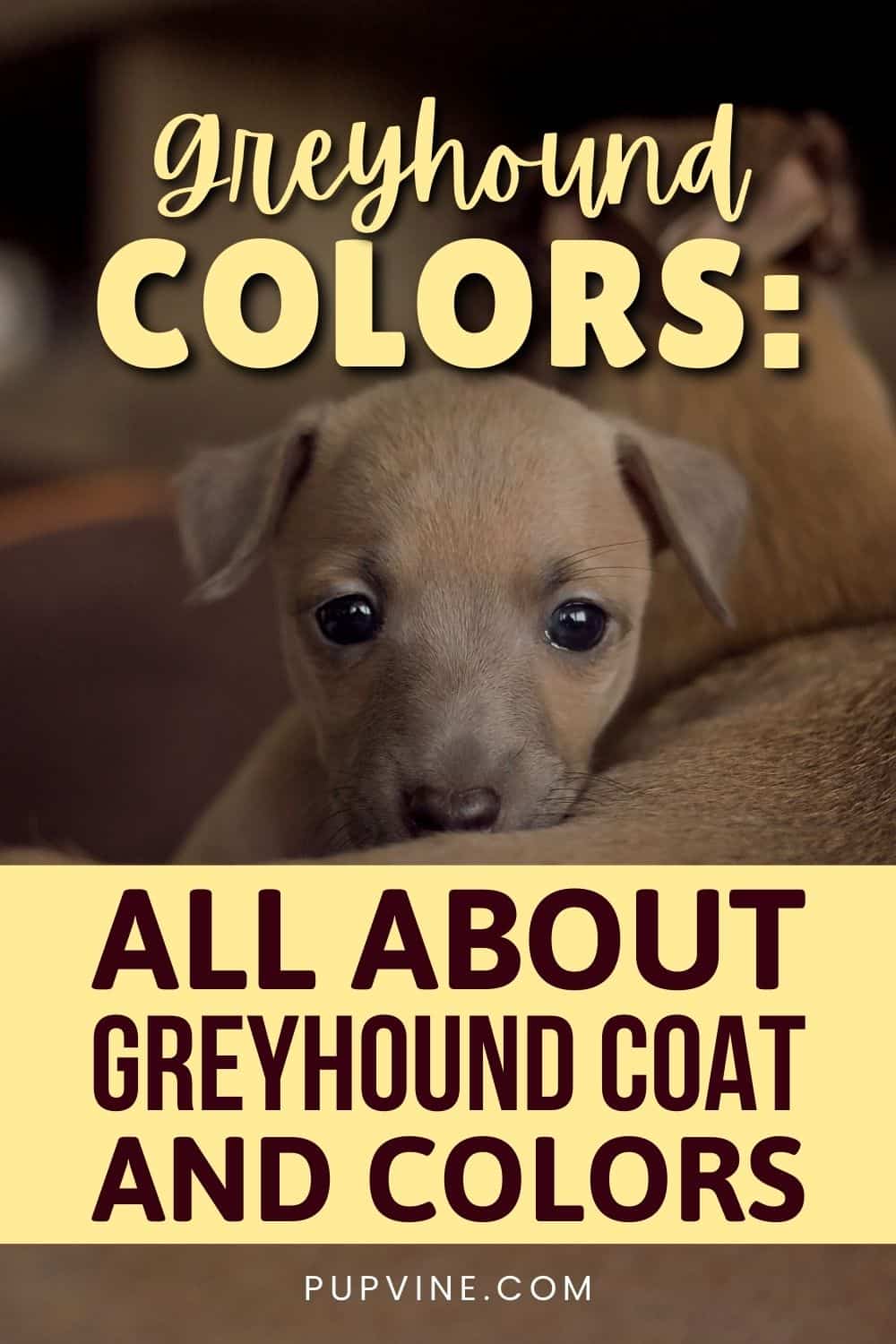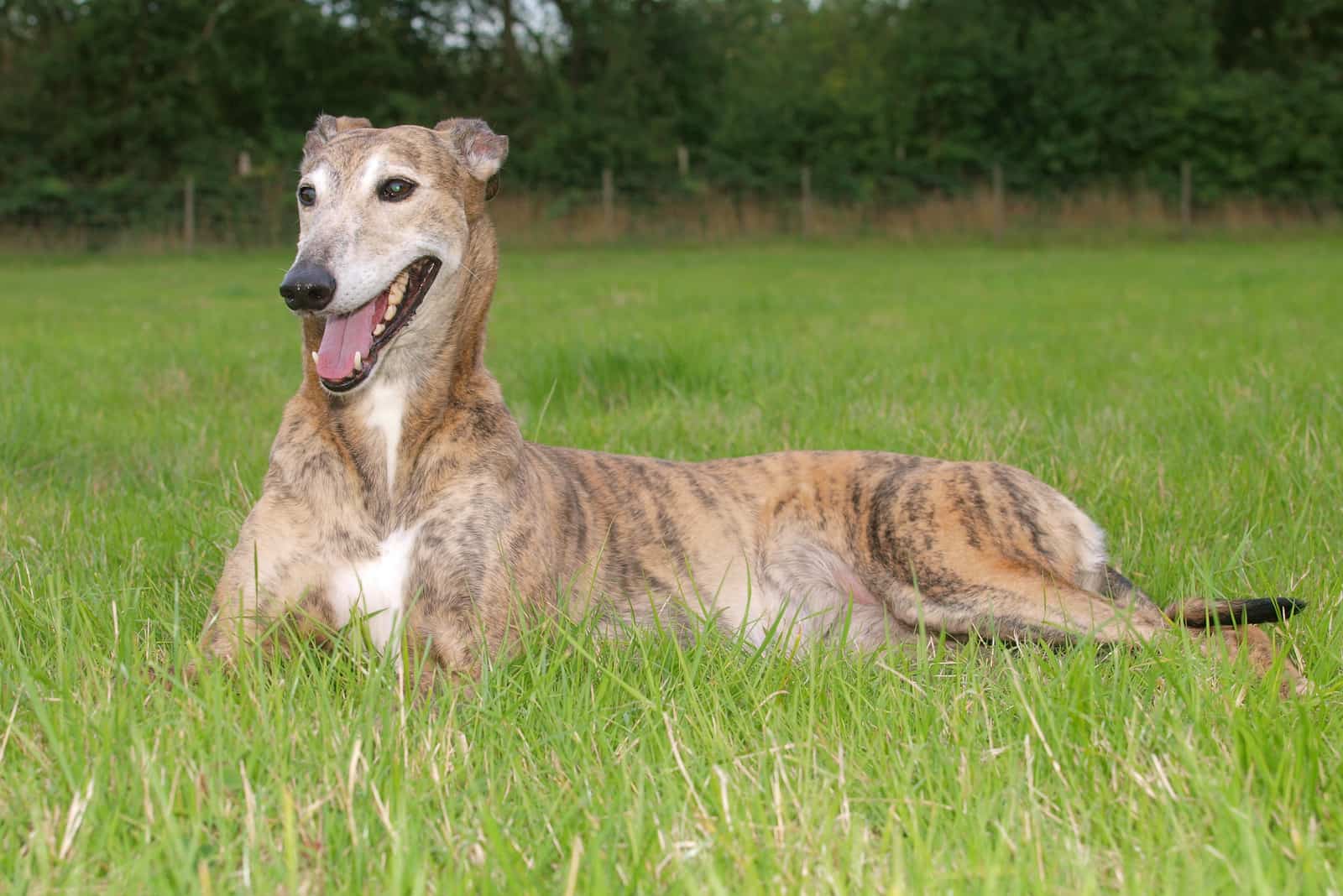Greyhounds aren’t the most popular family pet, but this isn’t justified. They are beautiful and delicate, and they can be a great addition to your household.
In fact, Greyhounds are one of the oldest dog breeds out there! These dogs were around 5,000 years ago, and they existed as hunting dogs for Egyptian pharaohs together with Saluki dogs. These godlike hounds were considered an extension of the ruler’s divine majesty, and they have kept that grace to this day.
Throughout the ancient world, from Macedonia to Moscow, nobles loved having these elegant dogs by their sides.
One thing not many dog lovers know is that Greyhounds come in a variety of colors. Even though their name has ‘grey’ in it, this is hardly even the most common color!
If this is something that interests you, you’re in the right spot. We’ll explain all there is about Greyhound colors and their coat, as well as answer some of the common questions about this dog breed.
Greyhound Vs. Italian Greyhound
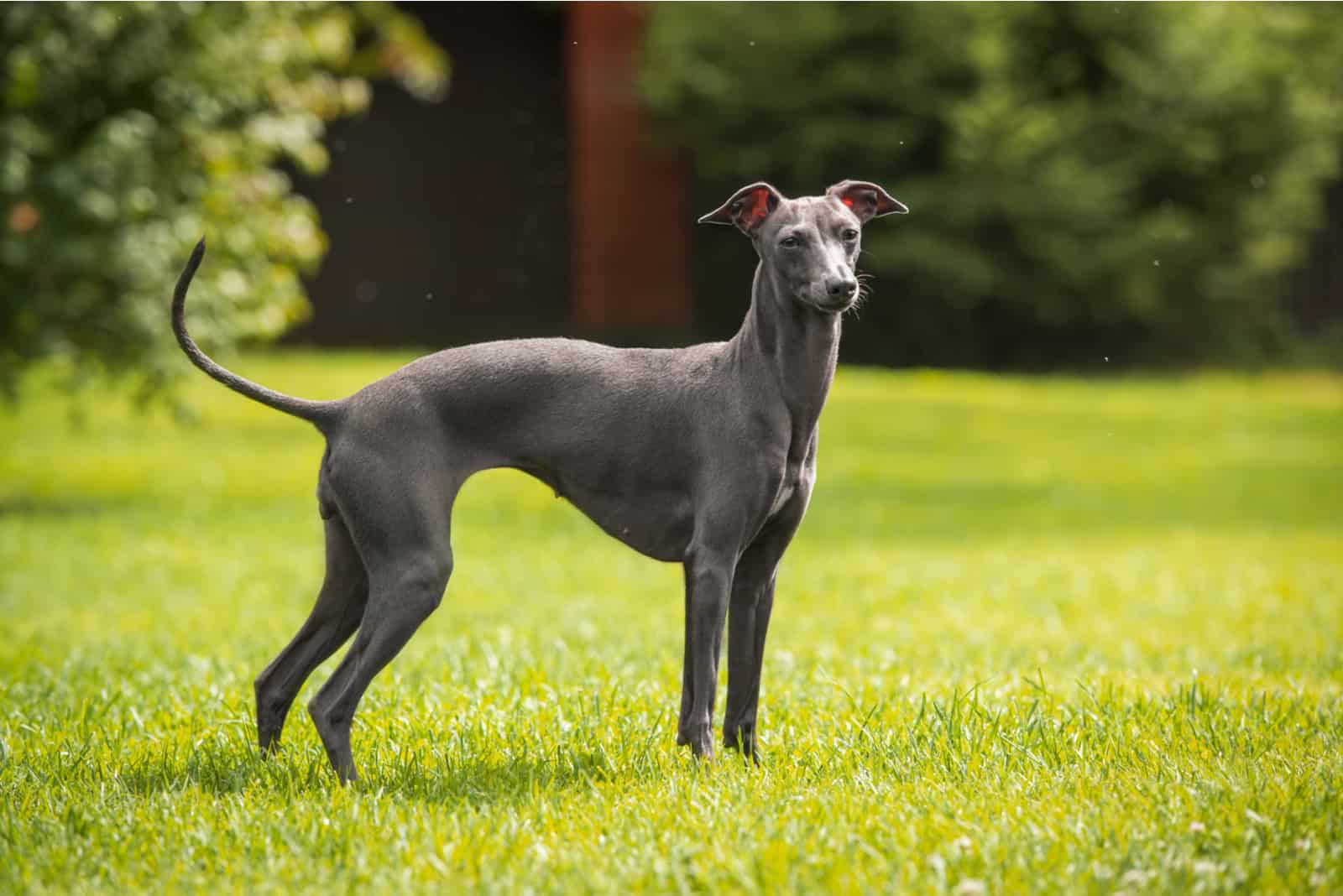
Before we go any further, there is one thing we need to clarify. The Greyhound isn’t the same dog breed as the Italian Greyhound. While these two dogs look alike, the Italian Greyhound isn’t just a miniature Greyhound. Many differences set these two breeds apart.
In fact, you could argue that the only thing similar between the Greyhound and Italian Greyhound is their body type. Everything else about them is very different.
The first difference you can notice is their size. The Italian Greyhound is much smaller than the standard Greyhound. In fact, while the average weight of an Italian Greyhound is 10–15 lbs, Greyhounds can sometimes weigh up to 100 lbs!
Temperament-wise, these are very different dogs. For example, while Greyhounds are eager to please, Iggies are more stubborn – but both are very loyal and make amazing family pets.
Italian Greyhounds are more cuddly and love to snuggle but are prone to separation anxiety, while Greyhounds love a bit of independence from time to time. Still, despite their size and coursing history, Greyhounds can be considered couch potatoes, while Iggies are borderline hyperactive.
While Greyhounds have a fairly strong prey drive and might not be the best choice if you already own other small dogs, Italian Greyhounds can deal with other pets really well. They’ll even be kind toward most small animals!
When it comes to coat colors, though, both types of Greyhounds come in more or less the same color variations, so this is one less thing to worry about.
Overall, some Greyhound owners want to own their small counterparts, but they can be unprepared for some unique challenges that come with the Italian Greyhound’s quirky personality. This can create a lot of issues down the road, so it’s always important to be informed before you make a decision.
Is Greyhound Racing Cruel?
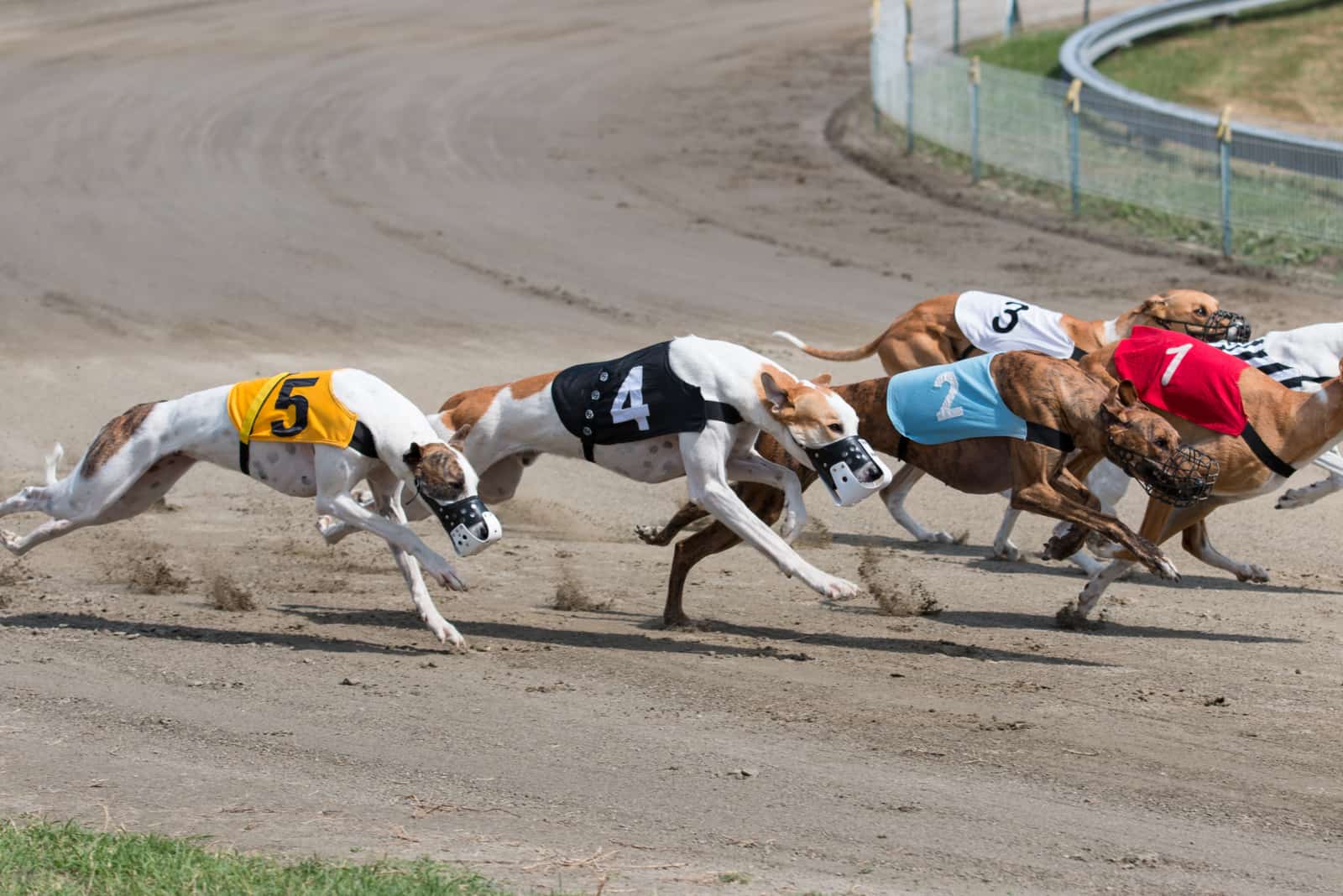
While Greyhounds were initially bred as hunting dogs, in the modern world, they were used as racing dogs. People would force them to race against one another for sport, and while this seems quite harmless and even fun, some humane societies have a different opinion on using Greyhounds as racers.
According to them, the problem lies in how Greyhounds are treated before, during, and after the race. They say that the breeders who bred racing dogs used to produce a larger amount of Greyhounds than was needed so that they could end up with the fastest dogs possible.
While these fast dogs were kept in small crates and sold to be used in races, a large number of the rest of the litters were euthanized as there weren’t enough dog owners willing to take them.
Then, many racing dogs would suffer injuries during races, and some would even die on the racetrack. When they weren’t racing, these social dogs would usually be kept in confined cages, which badly influenced their behavior.
All of this led to Greyhound racing becoming forbidden in approximately 40 US states, as well as many European countries. This means that many retired racing Greyhounds were left to look for forever homes.
While many business-oriented people and dog racing lovers were left fairly angry about Greyhound racing being banned, there is no doubt that all dogs do better being in a loving home instead of being used for sport or hard work.
Do Greyhounds Need To Wear Coats?
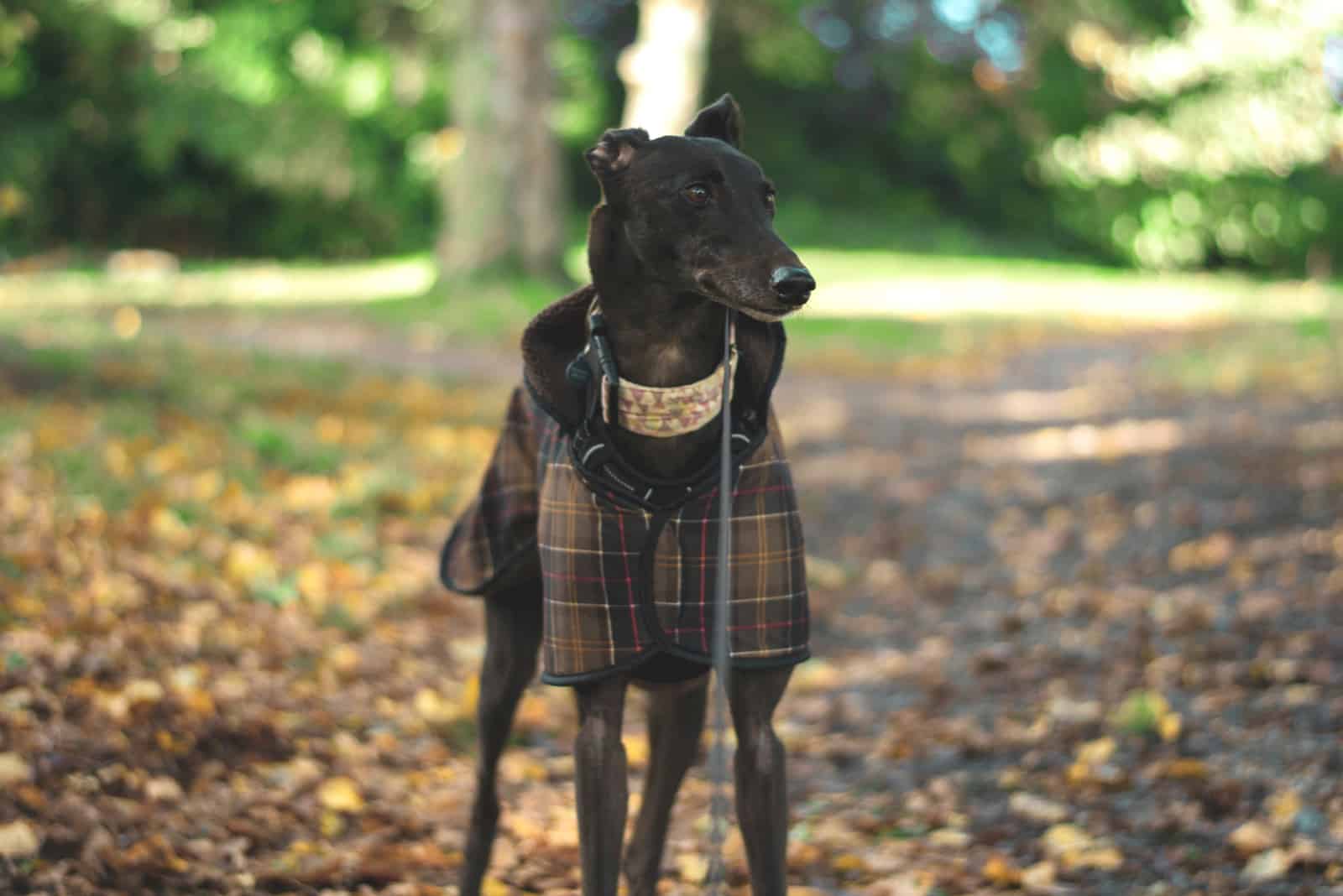
When looking for Greyhound pictures, you might notice that a lot of these tall pups are wearing coats – and we’re not talking about their natural fur! Dog owners love to dress them in jackets and other cute outfits. Is this necessary, or is it just a unique fashion statement?
Greyhounds have a short coat, and they don’t have an undercoat. At the same time, they are slim dogs without much body fat. All of this means they don’t have many things to keep them warm when the weather becomes cold.
So, yes, Greyhounds do need coats to keep them warm during cold, winter days. While this isn’t entirely mandatory, it can keep these pups from becoming sick or developing hypothermia.
A general rule of thumb: If you need to wear a coat, then your Greyhound should wear one too!
Keep in mind that Greyhounds also don’t do well in really hot weather. They are prone to heatstroke, so they shouldn’t be kept in a sunny backyard on very warm summer days.
You should make sure there is always a shady area for your Greyhound to lie and give him plenty of cool water. Getting a shallow doggy pool is also a good idea, as it can provide relief from the summer heat.
Greyhound Coat Colors
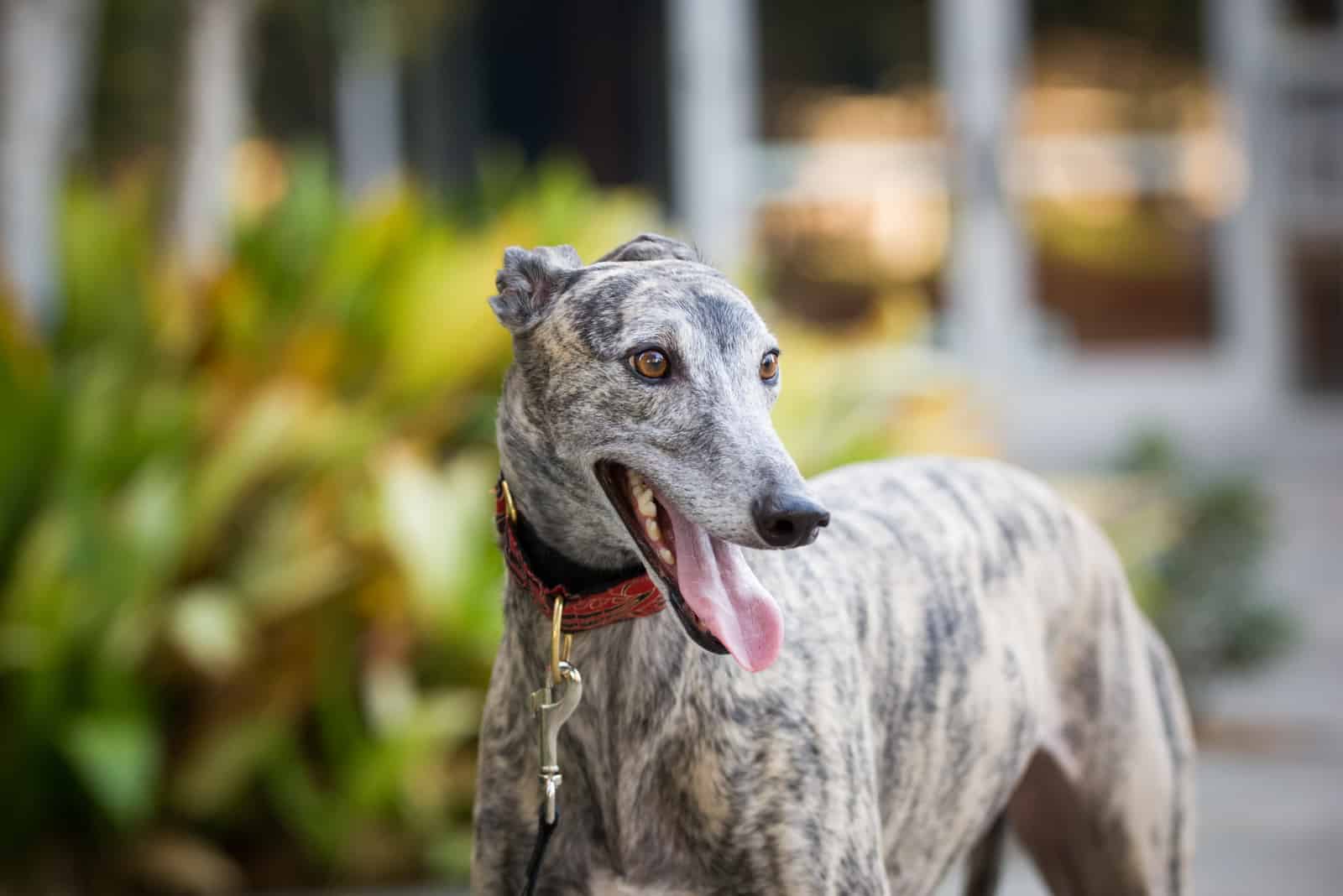
While Greyhounds sound like they only come in grey, this dog breed can come in almost any coat color, including black, white, red, blue, grey, or fawn. They can even come in various shades of brindle, although sable is rare.
The reason behind this high number of coat colors is because Greyhounds have existed for so long that many colors were introduced to the breed’s gene pool via crossbreeding with native dogs.
But, what determines Greyhound colors? We’ll explain.
Greyhound Colors Genetics
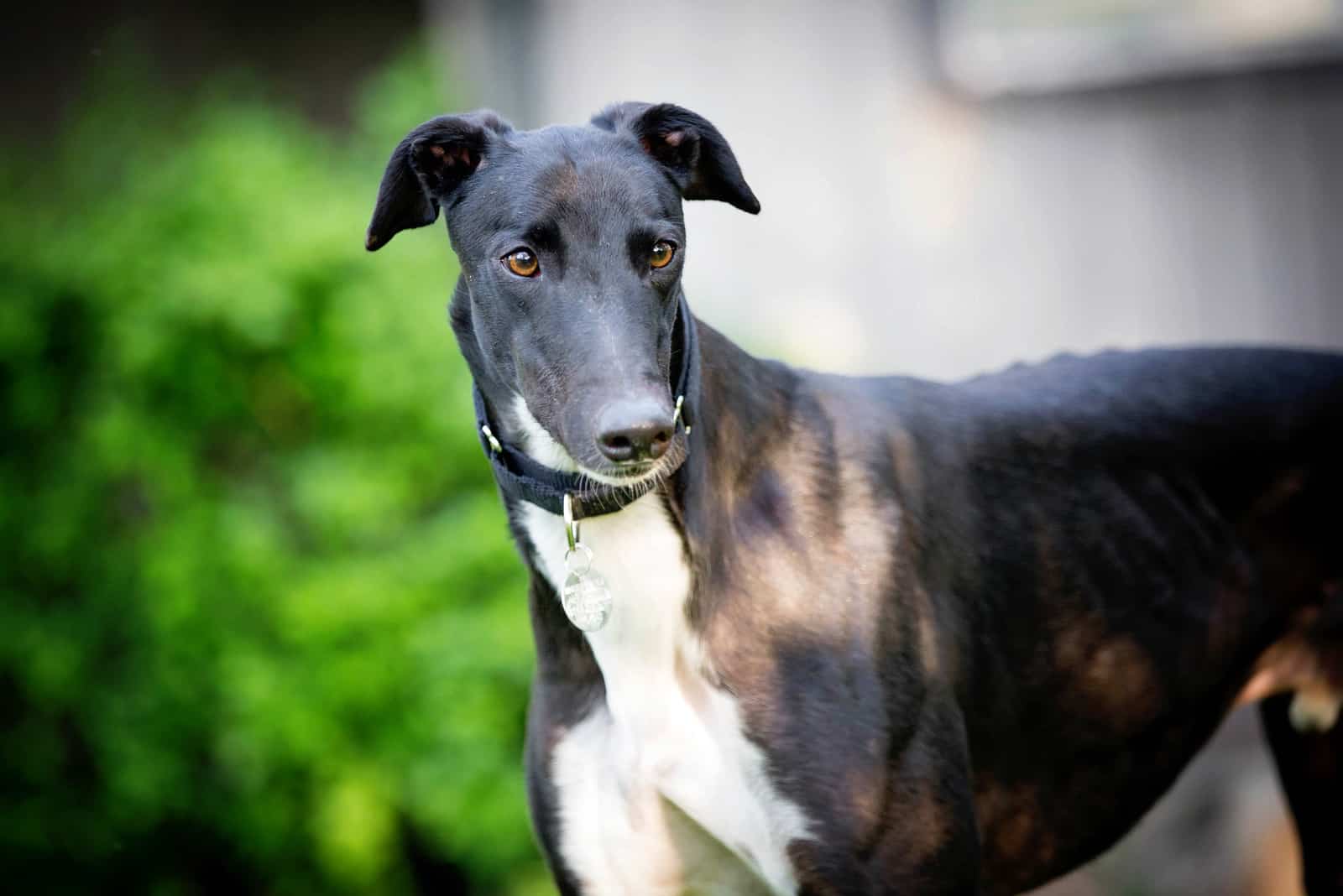
Each dog is born with 78 pairs of chromosomes that determine what dog breed it’ll be. One pair of chromosomes is inherited from the mother and another from the father.
Inside these chromosomes are genes that determine the dog’s features, and the exact feature they determine depends on the gene’s location. Some of them are responsible for the Greyhound colors.
A dog will receive a color gene – or allele – from each of its parents. This means that it will inherit one color gene from its mother and another from its father.
If these two genes are the same, that gene pair will be known as homozygous. A homozygous dog will only be able to pass that certain gene to its offspring.
On the other hand, a dog might have inherited two different genes, making him heterozygous. This is a bit more complicated.
You have dominant and recessive genes. A dominant gene will always express itself, while you would have to inherit two pairs of a recessive gene for that trait to be visible. If a dog inherits two dominant or two recessive genes, the stronger gene will ‘win over’ and be expressed.
Overall, the most dominant gene will be the one that will control the dog’s appearance.
Greyhound Colors Chart
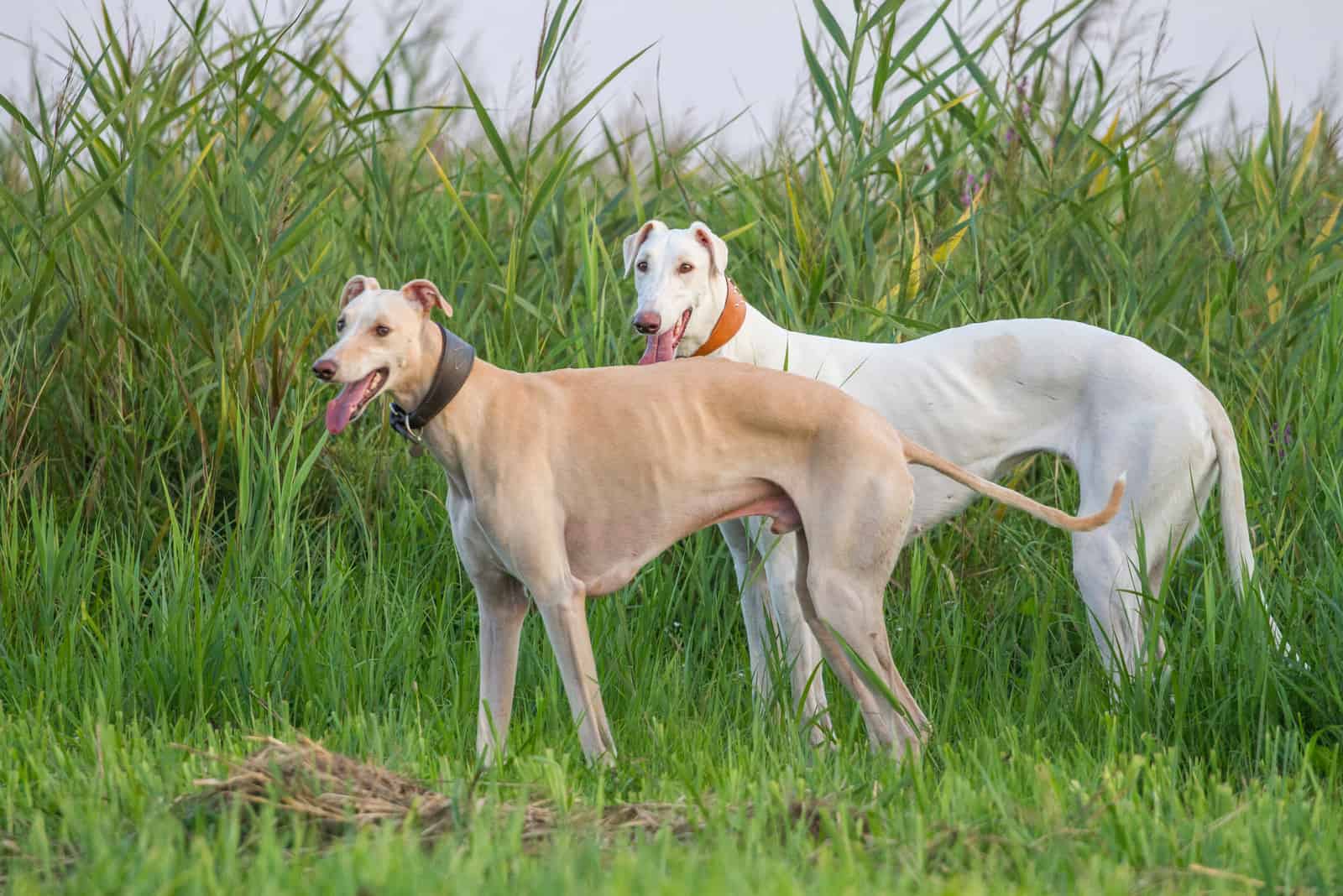
We’ll use a chart to try to explain how these genes are spread.
Overall, dominant genes are always labeled with a capital letter. For example, B stands for black-brown, but a dominant B would mean the coat color would express itself as black.
Opposite of that, recessive genes are expressed as small letters. You can also have b, which is a recessive form of the black-brown gene and expresses itself as brown.
If all the dogs could only come with this gene location, you could have three combinations:
• BB
• bb
• Bb
BB dogs are black in color, bb dogs are brown, but Bb are also black because B wins over the recessive b.
This is how the inheritance process works:
[table id=150 /]
As you can see, there are numerous possibilities, and the fact that recessive genes can stay hidden for generations only makes predicting the appearance of offspring much more challenging.
For example, you might have two black dogs who are also carriers of the recessive brown gene. If a puppy inherits that brown gene from both parents, he will be brown, even though both of his parents appear black in color.
Greyhound Colors And Markings
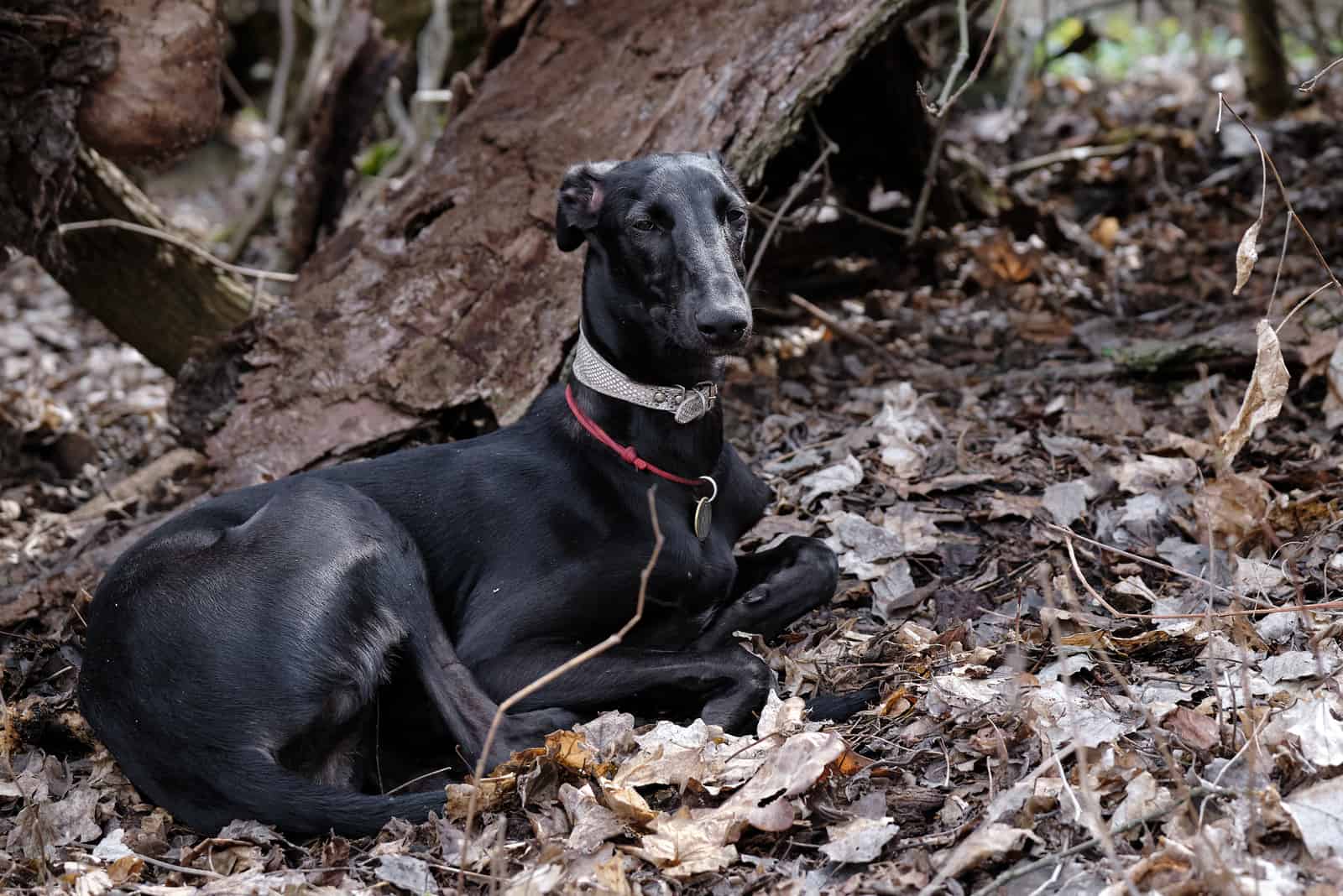
There is one issue with understanding Greyhound colors, as well as any other coat colors out there, and it lies within our vocabulary.
Sometimes, dog breeders, dog owners, or both use certain terms to describe their dog’s coat color. However, this might not be the official term used by kennel clubs, such as the American Kennel Club (AKC), United Kennel Club (UKC), or the Fédération Cynologique Internationale (FCI).
Kennel clubs have official terms that they use to describe a dog’s coat. For example, what would be registered as red brindle, you might call black (if there are too many stripes), or brown brindle (if the red is muddier in shade), but these would still be considered red brindles genetically.
Keep in mind that these colors apply only to purebred Greyhounds. Greyhound crossbreeds, such as the Greyhound mix with Corgi, or the Greyhound German Shepherd mix, can come in many other coat colors.
This is because other breeds can come in plenty of other colors that they can pass onto the offspring. For example, Corgis can come in red, fawn, even merle, adding these colors to the gene pool.
Most Common Greyhound Colors
As mentioned several times before, there are many Greyhound colors. However, not all are equally as common.
After reading how genetics influence Greyhound colors, it can be easy to conclude that dominant genes will be more common as they are easier to express themselves. However, this isn’t always the case. If a gene is rare as it is, then it won’t have many means to spread, so whether it is dominant or not, it won’t be as present in the gene pool.
The most common colors in Greyhounds are brindle, black, red, and fawn. While grey is probably the most popular one, it is far from being the most common.
AKC Greyhound Colors
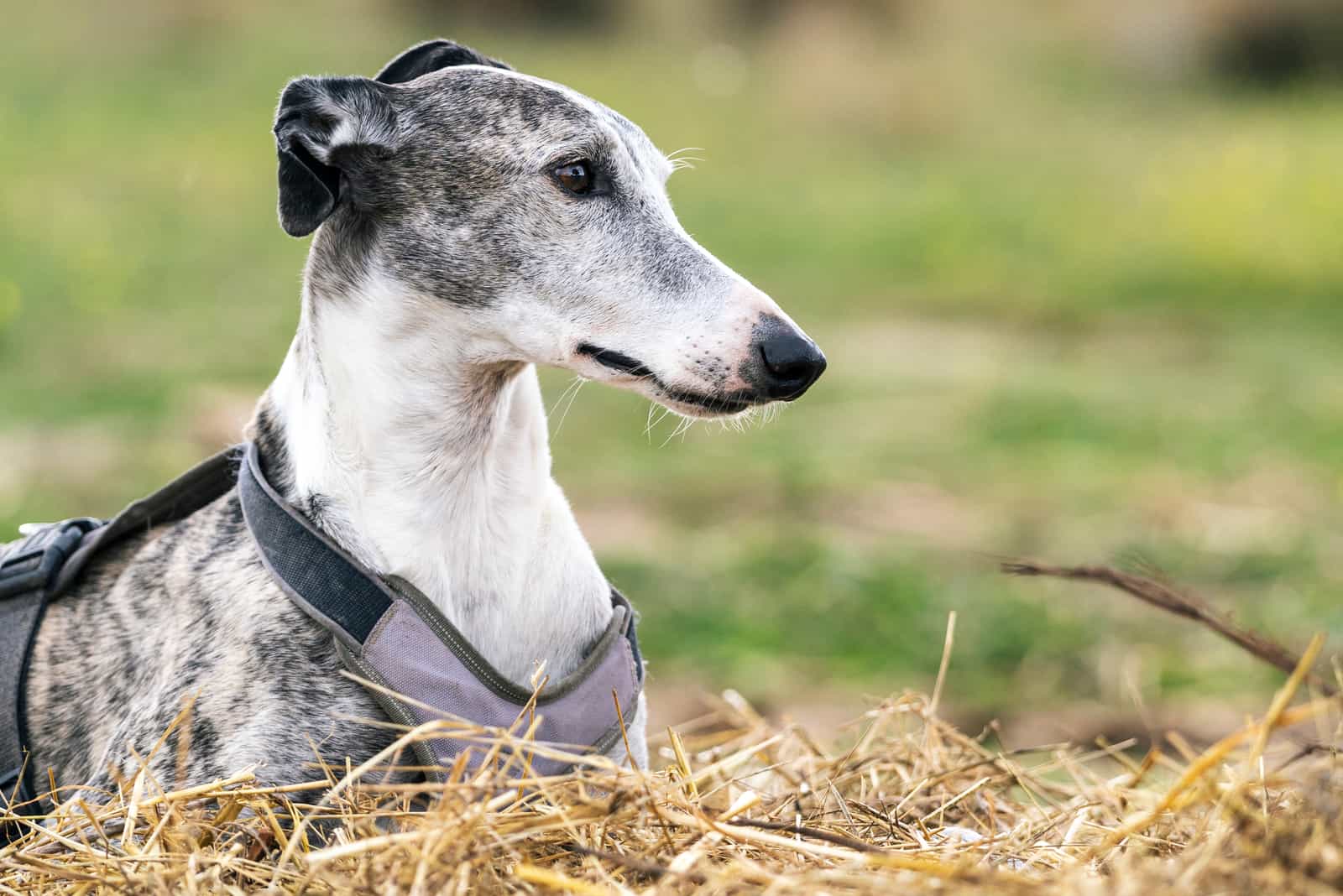
Some coat colors are accepted by kennel clubs, while others aren’t. Don’t worry if your doggy doesn’t come in an approved color. This doesn’t necessarily mean that there is something wrong with him or that he isn’t purebred.
A dog that isn’t an approved color is most likely just not going to be able to participate in dog shows. Some will be able to be registered but under a different name. For example, a mahogany dog will most likely be registered as red.
Fortunately, almost all Greyhound colors are accepted by the AKC. This includes:
• Black
• Black brindle
• Blue
• Blue fawn
• Blue brindle
• Red
• Red brindle
• White
• White and black
• White and red
• White and blue
• White and black brindle
• White and blue brindle
• White and blue fawn
• White and red brindle
You’d still be able to register other Greyhound colors, such as fawn, liver, brindle, black and white, or blue and white, but they would be listed as ‘alternative.’
While most color combinations in which one of the two colors are white are perfectly fine, there are two exceptions, and this includes dogs with tan markings or merle.
There are also some markings that are perfectly fine by the AKC, and this includes:
• Solid
• Black mask
• Ticked
• Parti
Why Are Some Greyhound Colors Disqualifications?
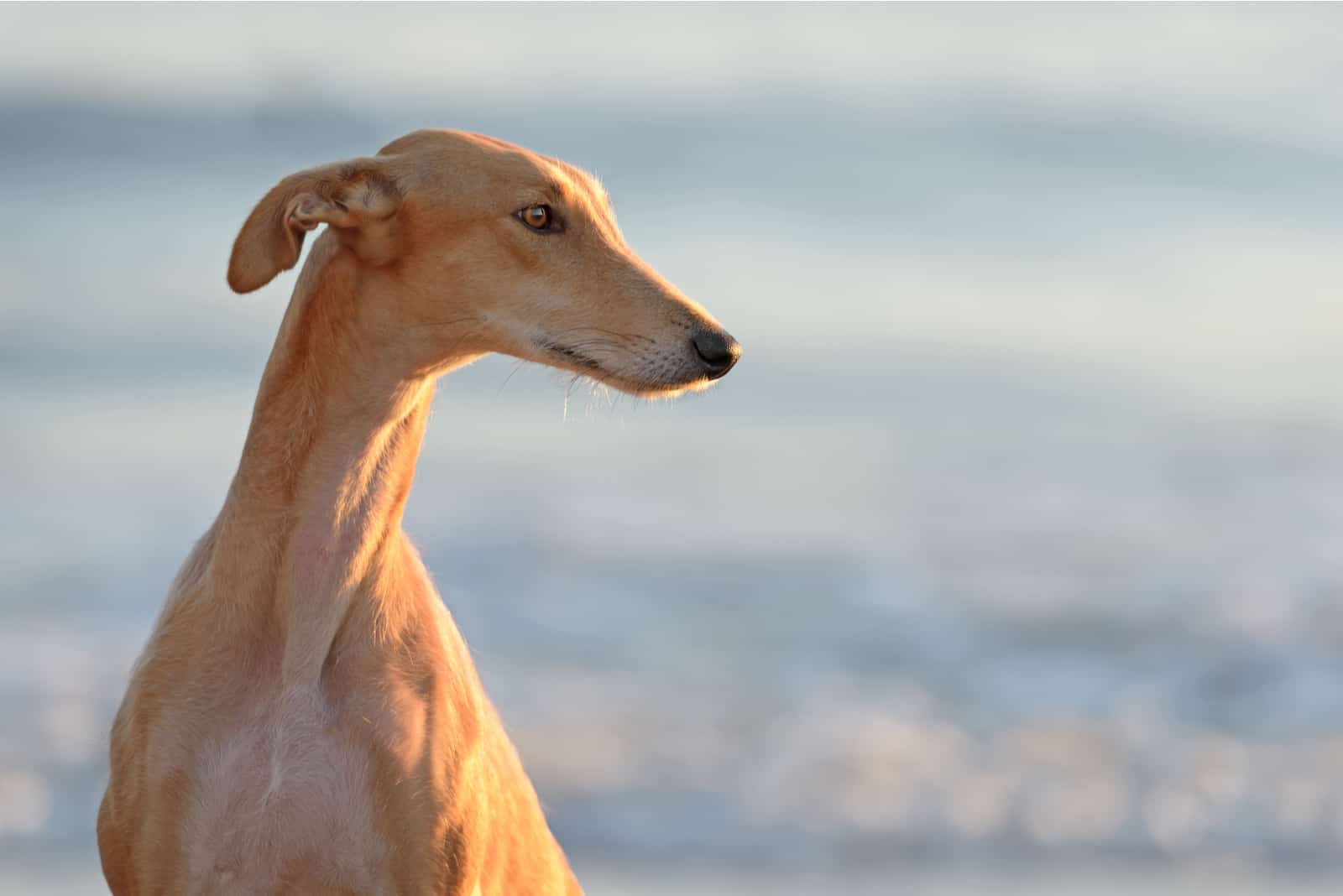
It isn’t always clear why some coat colors mean disqualification from conformation shows, as there are a few reasons behind this.
Some colors are disqualified because they don’t come naturally in that dog breed’s gene pool. Instead, they are introduced by crossbreeding, which means that the specific dog isn’t purebred.
Other coat colors are connected with certain health issues, which is why spreading some of them is frowned upon. This is the case with merle, for example.
In the case of Greyhound colors, it isn’t exactly clear why tan markings are forbidden.
Greyhound Colors
To help you visualize how these dogs look, we’ll explain some of the most common Greyhound colors.
Let’s begin!
Greyhound Colors Fawn
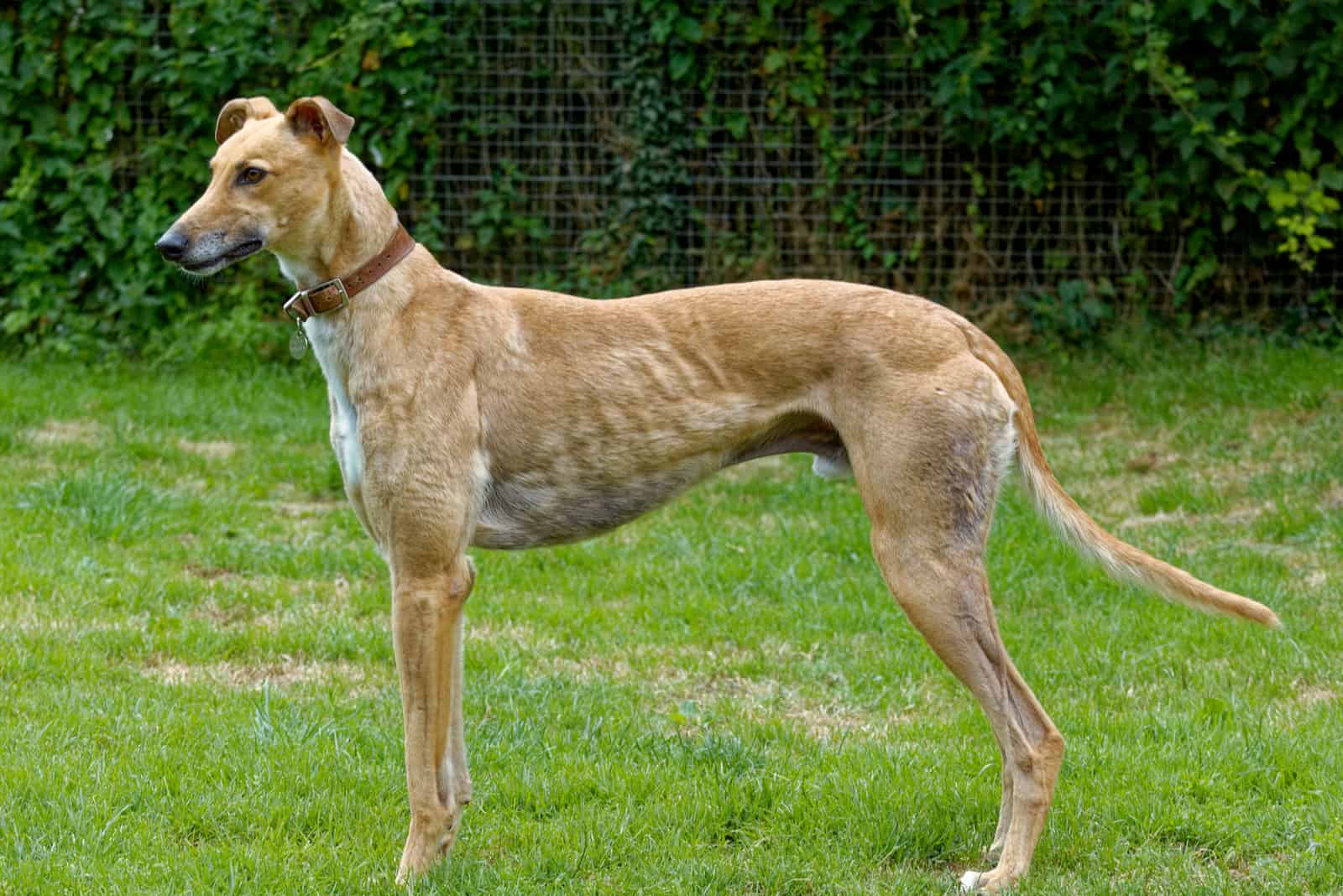
Fawn is, actually, a light yellowish tan color – although it isn’t the same as regular tan shade, which is usually deeper, almost rusty. This is one of the most common Greyhound colors out there.
Depending on the dog’s genetics, you can find several fawn shades. For example, you may have a red fawn (also known as Isabella) or a blue fawn.
Regular fawn Greyhounds have a black nose, eye rims, paw pads, and lips. If the nose is blue, the dog will be registered as a blue fawn. On the other hand, a brown nose would likely mean a dog is liver-colored.
Greyhound Colors White
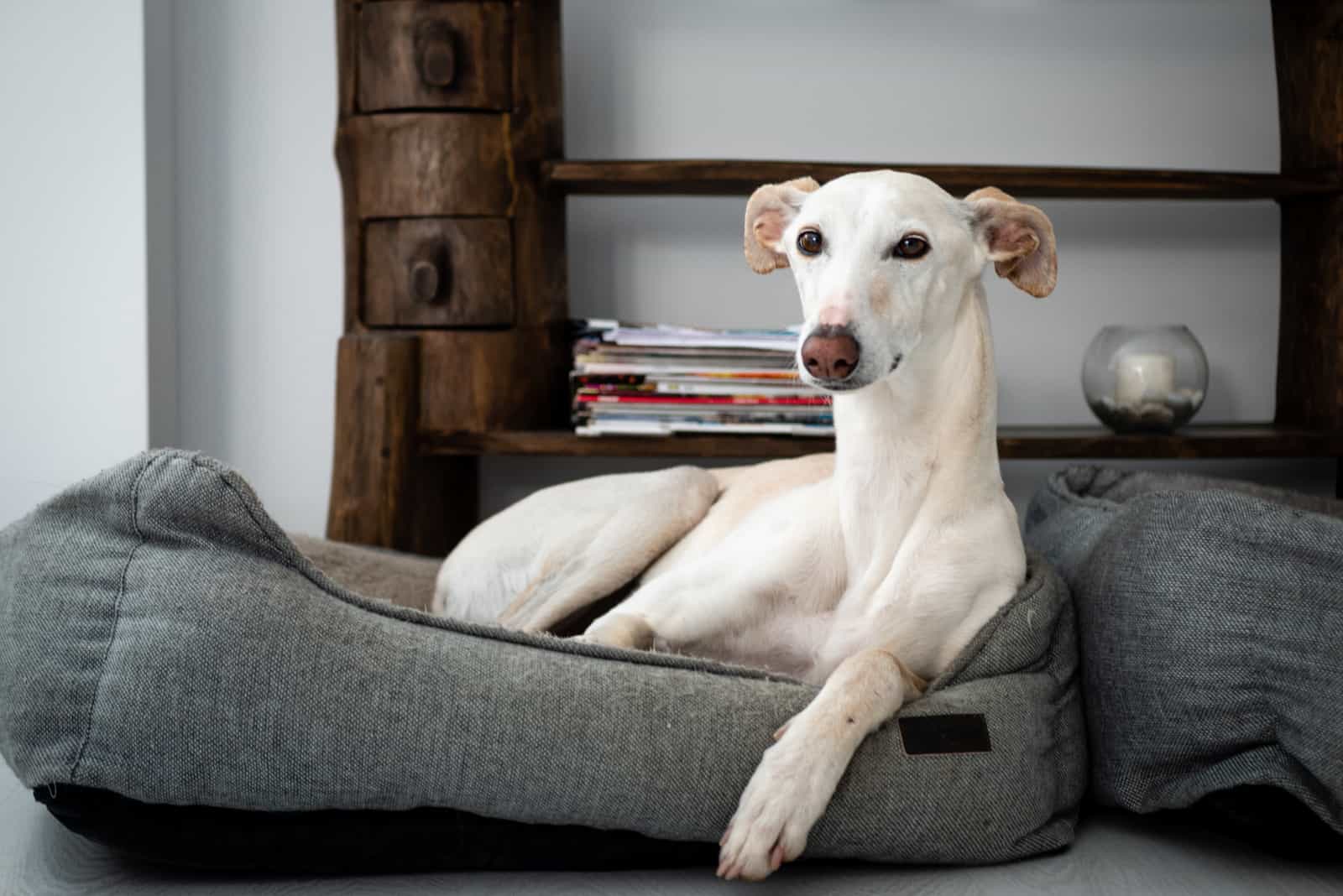
While pure white Greyhounds are rare, many Greyhounds have a white base coat with specific markings. You can easily find white and red Greyhounds, white and black Greyhounds, or even white and blue Greyhounds.
On the other hand, most white markings (when a dog has a specific base color and just a few white stripes) aren’t desirable.
Greyhound Colors Black
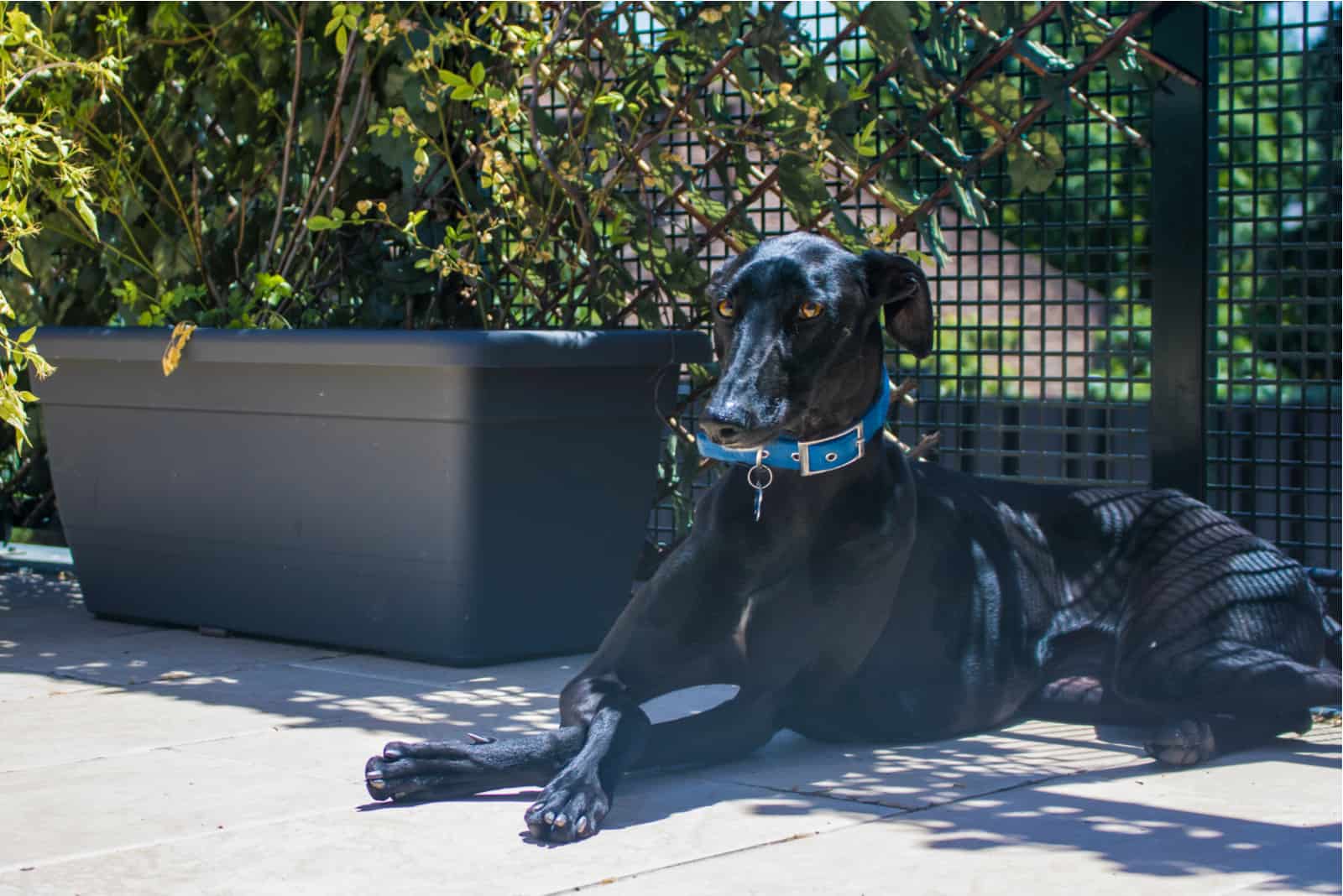
Black is the most dominant coat color in dogs. In fact, in a solid black dog, no other color can be present anywhere else on the dog’s body, including his skin. This is why all black Greyhounds also have black noses, eye rims, feet pads, and lips.
However, black is one of the rarest Greyhound colors. Black Greyhounds are challenging to find, and they’ll often have a very sleek appearance. This isn’t a surprise, as black can be a fairly rare color in many dog breeds, such as the Shih Tzus or Shiba Inus. Most of the time, black is present in the form of markings – usually on a white base coat.
Greyhound Colors Blue
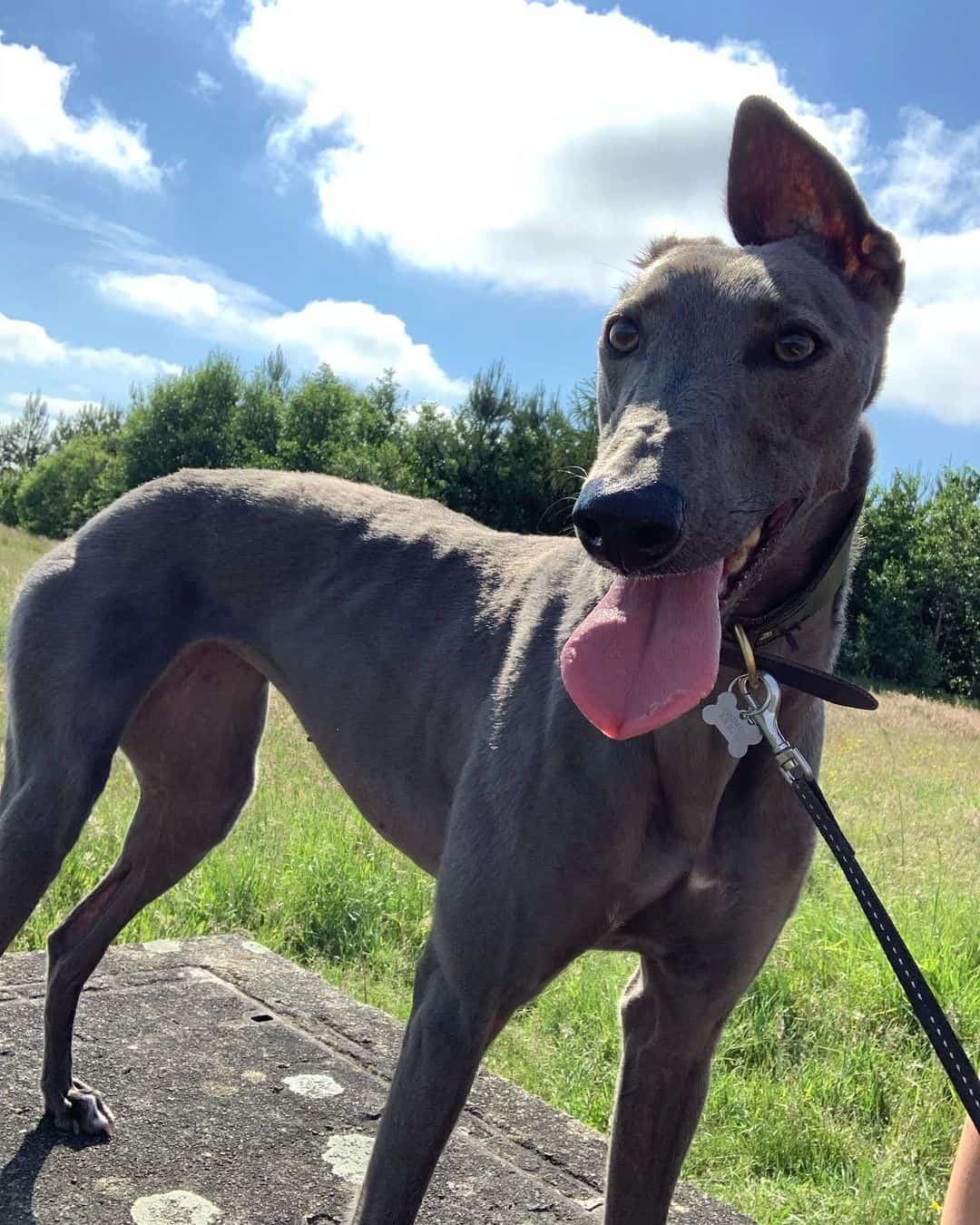
Photo from: @diva.the.greyhound
Blue is the result of a dilution gene mixing with black. This gene turns black into a unique shade of grey with a blueish tint, hence the color name.
However, one thing that makes blue Greyhounds stand out from other colors is that this dilution gene doesn’t necessarily have to affect the Greyhound’s coat. What’s important is that it affects the dog’s eyes and skin.
In other words, you may have a blue Greyhound with almost any coat color. As long as its nose is blue, the Greyhound will be considered blue as well.
Still, this dilution gene will almost always affect the base coat color to some extent, resulting in beautiful shades – such as the already mentioned blue fawn.
Greyhound Colors Brindle
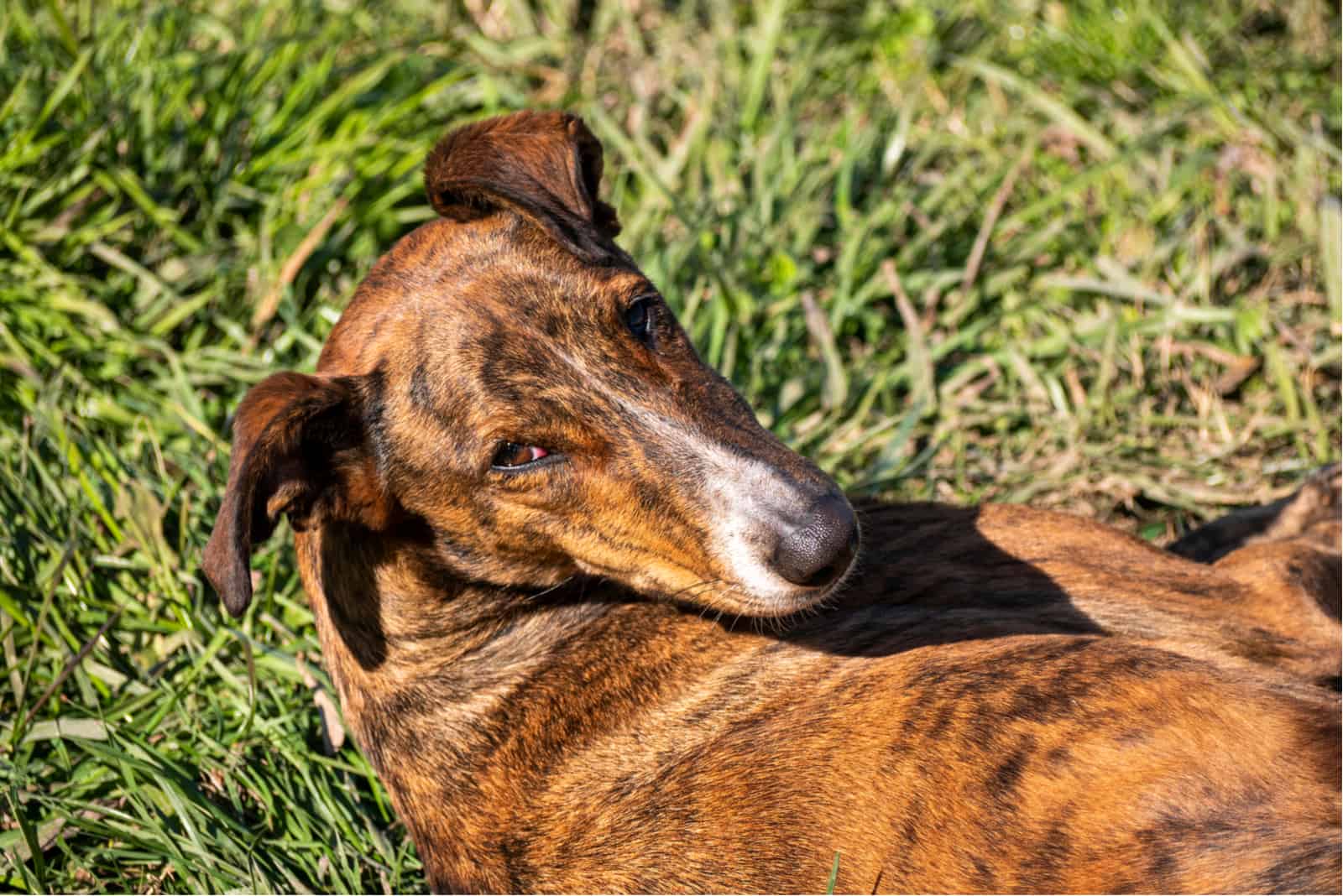
Brindle dogs are, in fact, dogs with black stripes. If you see a dog with tiger-like stripes, that’s a brindle dog.
These stripes can be more or less wide. If they’re wide enough, your Greyhound might even appear black.
Also, brindle can come on all base coats. Depending on which, you can find a liver brindle, red brindle, fawn brindle, even black brindle!
Brindle can affect your dog’s entire fur, or it can come in the form of markings. Both are perfectly acceptable according to the breed standard.
One of the Greyhound’s ‘cousins,’ the Whippet dog, is commonly found in brindle color. If you find a brindle Greyhound that is smaller than the rest of the breed but still larger than an Italian Greyhound, chances are this is a Whippet.
Greyhound Colors Red
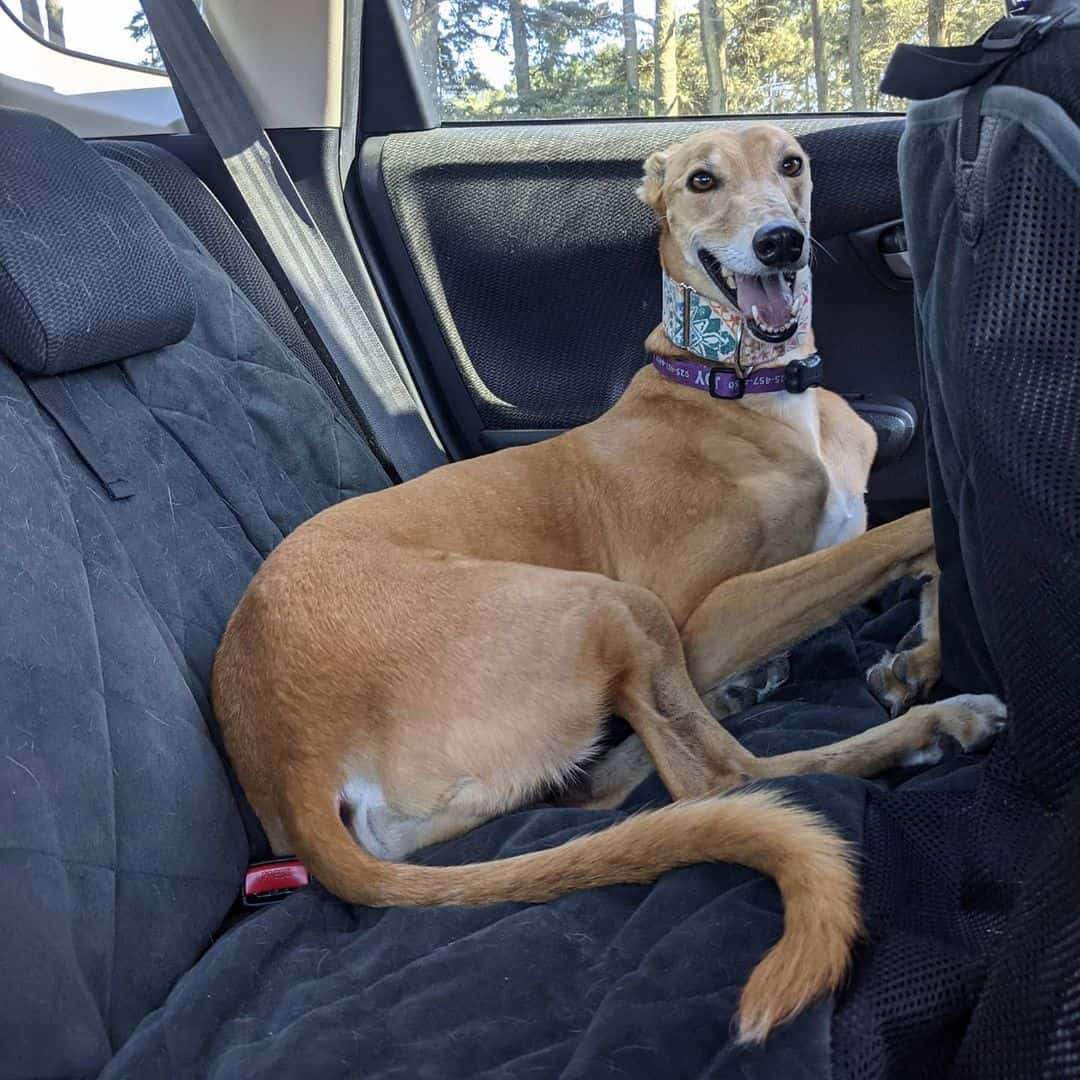
Photo from: @greyt.joy
Red Greyhounds come in a deep, rich color that ranges from almost bright orange to deep mahogany. They have black noses and black eye rims, paw pads, and lips and usually have very dark eyes.
While red is a very common color in the dog world (especially in breeds such as Goldendoodles or Boston Terriers), it is somewhat rare in Greyhounds but not impossible to find. Most of the time, red markings are found on white dogs.
Non-Standard Greyhound Colors
Unlike the colors mentioned above, some coat colors don’t fall inside the breed’s standard. Here are some of them:
Greyhound Colors Grey
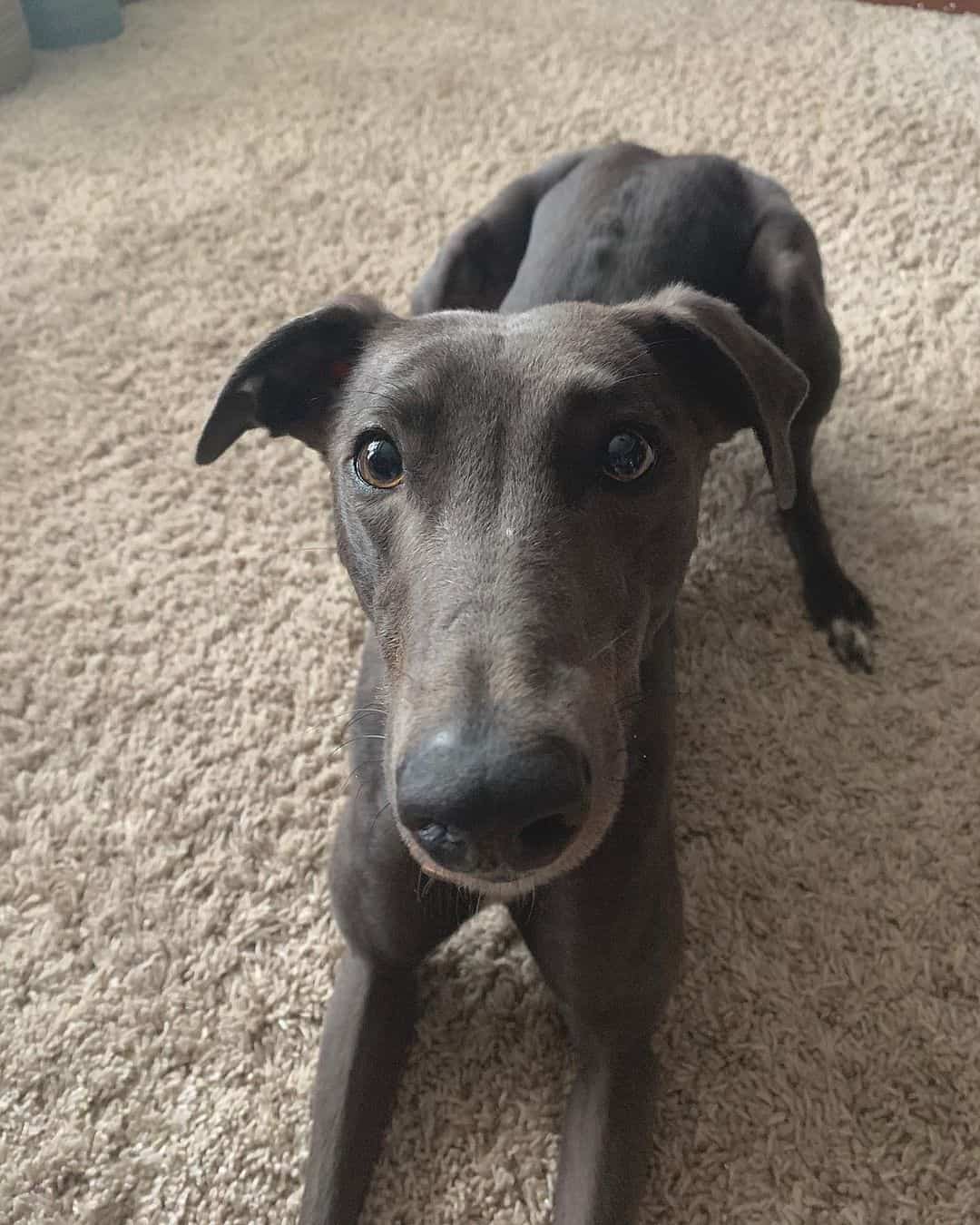
Photo from: @pawtimepaige
Despite the color being in the breed’s name, grey isn’t a standard Greyhound color – but blue is.
Grey dogs look more or less like blue ones but without a blue tint. Some might even have dark, almost black noses.
Most of the time, grey Greyhounds will be registered as blue Greyhounds.
Greyhound Colors Slate Grey
While slate grey is a common color in Italian Greyhounds, it isn’t as common in standard Greyhounds.
This is, essentially, a shiny grey color that looks a bit like silver.
Most of the time, slate gray Greyhounds don’t come in a solid color but rather have a few white markings – another reason why they don’t fall within the breed standard. Still, they can be registered.
Greyhound Colors Sable
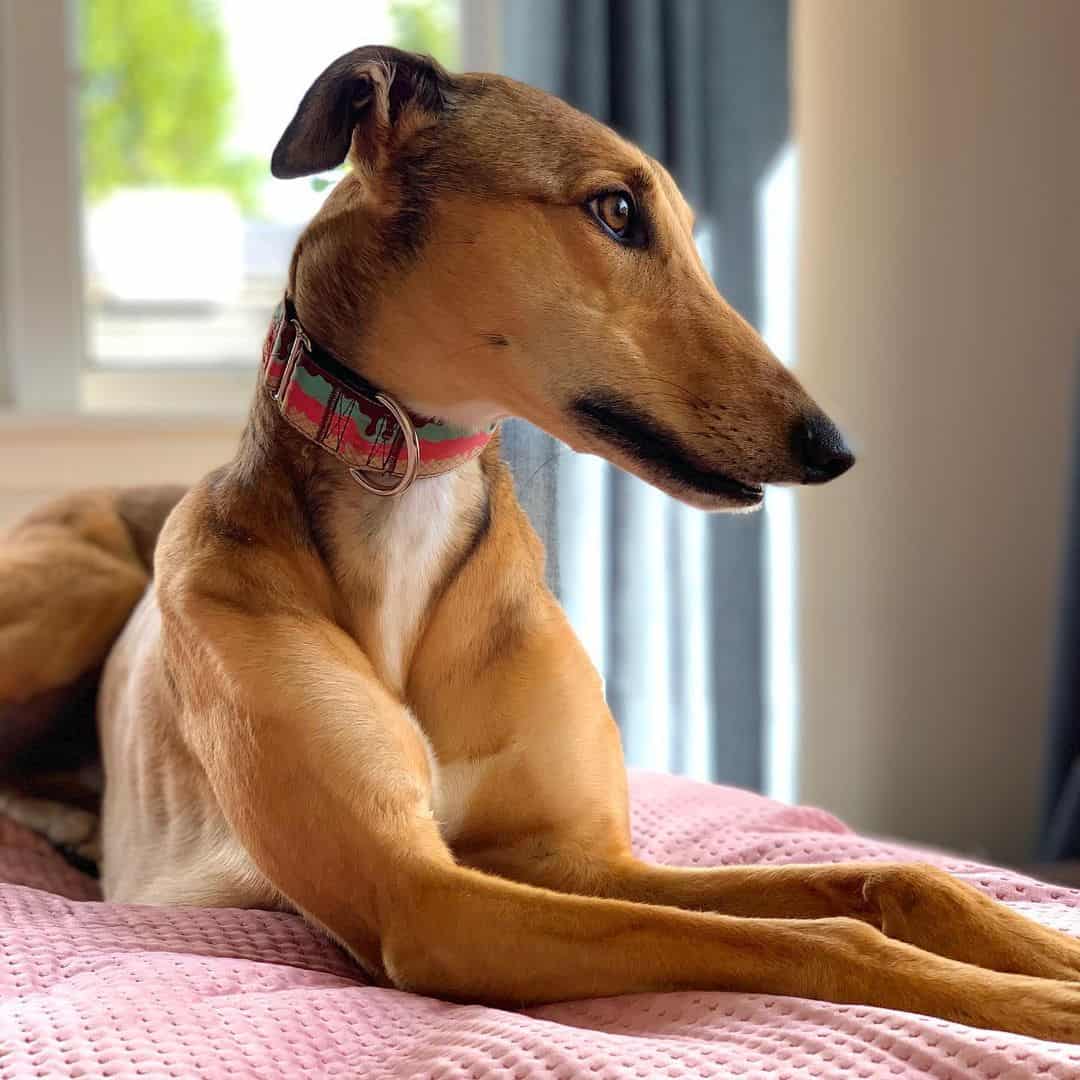
Photo from: @blushinperson
The sable color is when a dog has a certain base color, but its hairs have black tips. This can make a dog appear much darker in color than he really is.
Just like brindle, black tips can occur on any base color. However, it will be much more noticeable on lighter coats, such as fawn or red.
Greyhound Colors Liver
Liver is another dilution of the black color, except that it turns the black into a brown color. This isn’t noticeable just on the dog’s coat but also on its skin.
Similar to blue Greyhounds, liver dogs might also come in various colors. What makes them true liver is their nose and eye color. If a dog of any color has a brown nose or amber eyes, then he is a liver Greyhound.
This dilution gene is supposedly connected with a small increased chance of certain health problems. It isn’t enough for the color to be banned (you can still register liver dogs under the alternative label), but you should be aware of that.
Greyhound Colors Merle
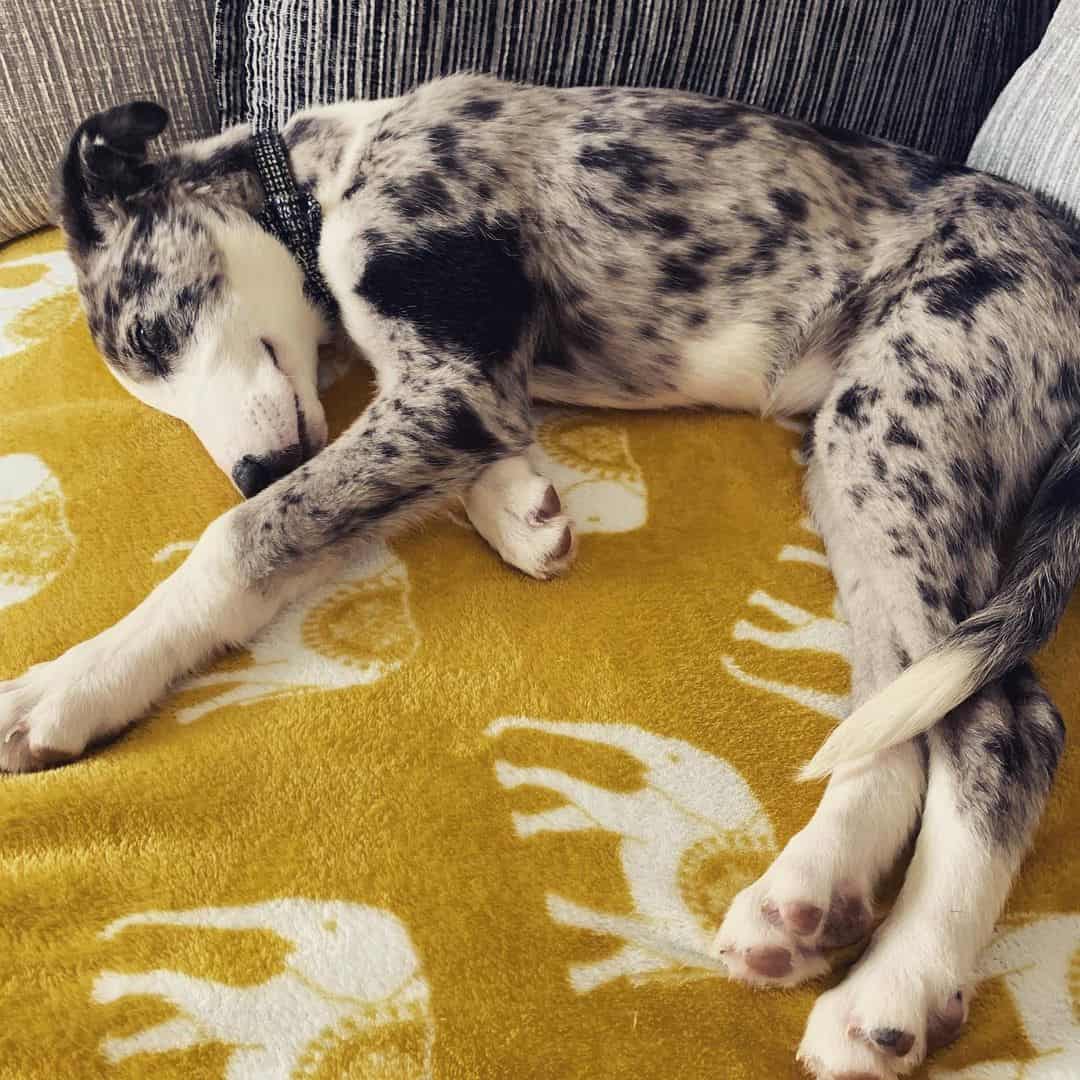
Photo from: @life.of.loki.the.pup
Merle is the most controversial of all Greyhound colors. This is because this gene is proven to be connected with a large number of health problems, most notably:
• Blindness
• Deafness
• Heart problems
• Bone problems
• Some cancers – most notably osteosarcoma
Because of this, the intentional breeding of merle dogs, especially homozygous merles, is frowned upon.
Merle is caused by a dilution gene. When a dog inherits only one merle gene, he will get a specific merle pattern, which looks like at least three colors were splattered on your dog.
This dilution also affects a dog’s eye color, so merles will often have complete or partial heterochromia or entirely blue eyes.
If a dog inherits two merle genes, he will be pure white with blue eyes. Unfortunately, he will almost certainly be deaf, and the chances of him developing some genetic disorder are as high as 70%.
Color Markings In Greyhounds
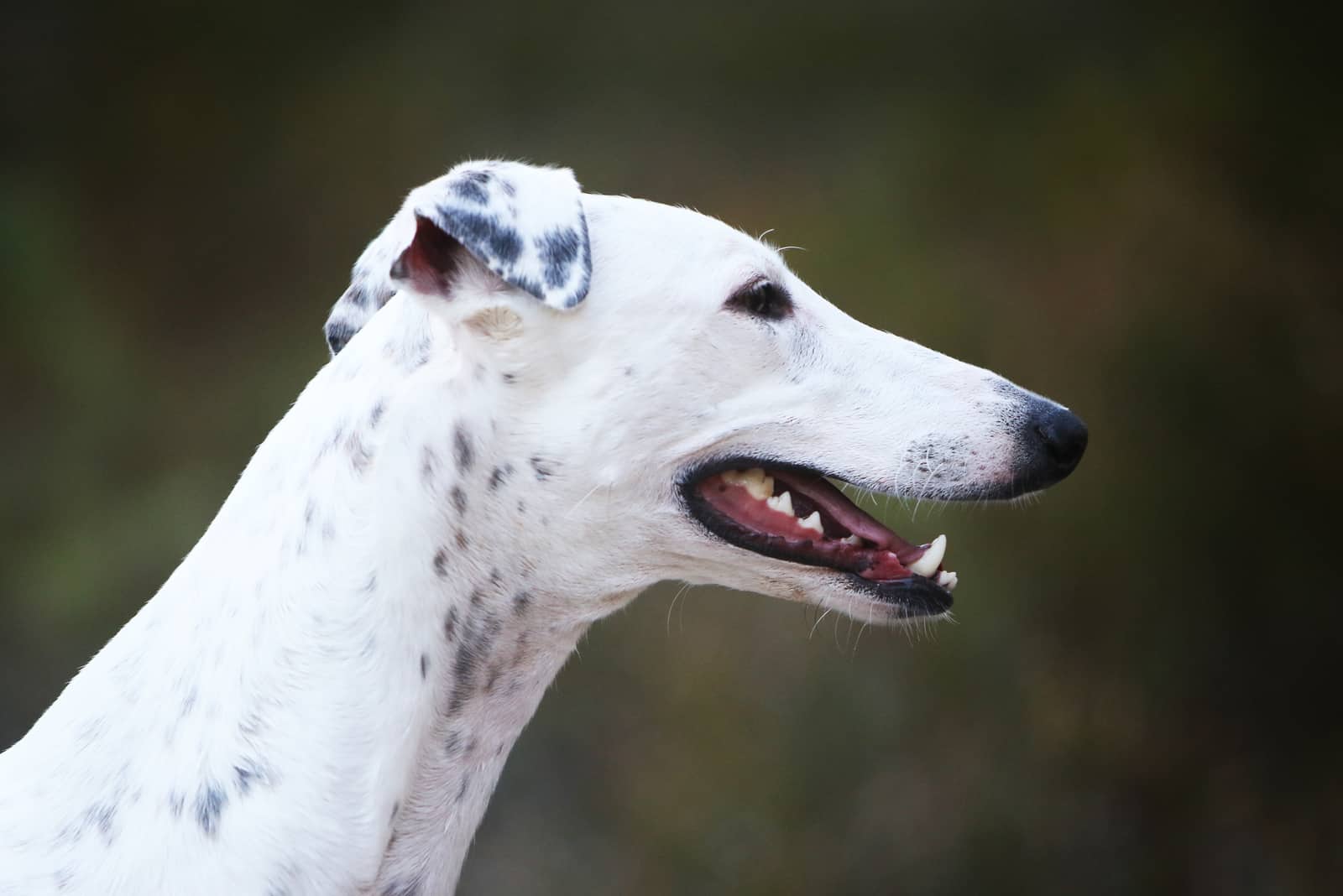
Some genes also determine how the pigmentation will be distributed across the dog’s fur. All of the Greyhounds’ colors can come in either a solid color or in one of three types of allowed markings.
These markings are:
Black Mask
A black mask is when a dog has black fur on his muzzle, which sometimes stretches all the way around his eyes, but it usually only affects the area around his lips and nose.
A black mask is often seen in white and red Greyhounds, but it can be found in other coat colors as well – with the exception of dog colors that are the result of a dilution gene, such as blue or liver.
Ticked
Ticked dogs are dogs with spots – such as Dalmatians. Greyhounds can often come in this pattern.
In fact, most white Greyhounds will have at least a small amount of spots in some other color, usually black or blue.
Parti
Parti is short for ‘partially colored.’ It includes spots of color on a base of a different color.
In Greyhounds, parti is a fairly common pattern. Many white Greyhounds have parti-colored markings on their coats. These patterns can be opposite – white markings on a colored coat – but most of these dogs will have to be listed as alternative.
Irish
Another common white pattern that is usually registered only as ‘parti’ is the Irish pattern.
This is when the white marking goes up around a Greyhound’s neck, resembling a collar. However, it doesn’t extend far up the dog’s legs or to the sides of his body.
There is also the ‘Wild Irish’ pattern, which is similar to the Irish, but with the white parts extending past the neck, sometimes also covering the dog’s entire legs.
Rare Greyhound Colors
Just as some Greyhound colors are fairly common, others are very rare.
Believe it or not, a fairly rare coat color in Greyhounds is, in fact, grey!
Most other rare Greyhound colors are also connected with the color grey, such as a blue brindle. However, blue spots on a white Greyhound are somewhat more common.
Another rare color in Greyhounds is solid black. Pure black Greyhounds are almost impossible to find, although black markings are common on white dogs.
Italian Greyhound Colors
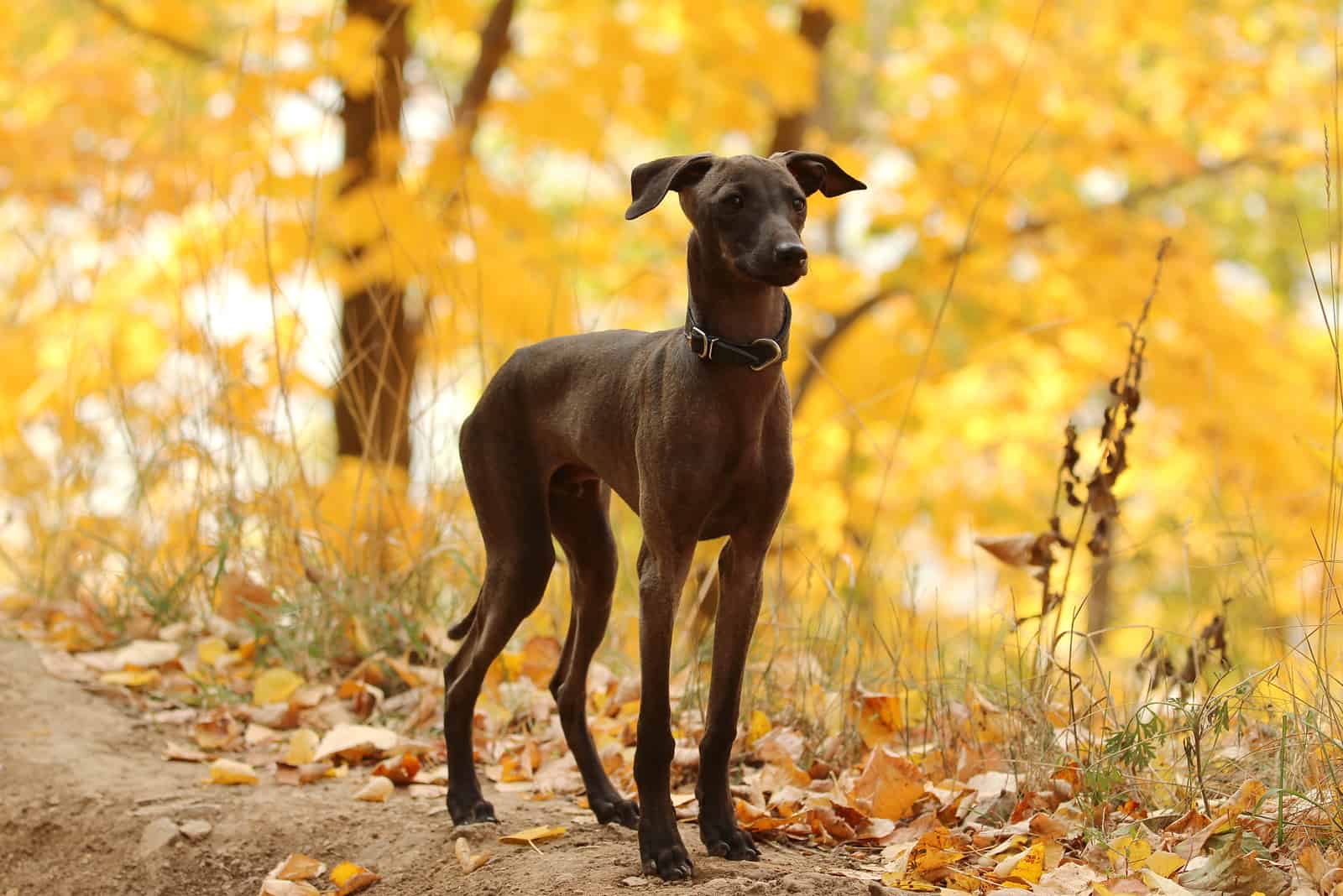
We’ve talked about the differences between Greyhounds and Italian Greyhounds. Well, another difference is that the standard colors for Italian Greyhounds aren’t the same as Greyhound colors.
According to the AKC, acceptable colors for Iggies are:
• Black
• Blue fawn
• Blue
• Cream
• Fawn
• Red
• Red fawn
• Sable
• Seal
• White and black
• White and fawn
• White and red
• White and sable
• White and blue
• White and red fawn
• White and seal
• White and blue fawn
As you can see, there is a greater variety of colors in small Italian Greyhounds than in the original Greyhound breed. This is another reason why some Greyhound owners want to own their smaller counterparts too.
Greyhound Colors Temperament
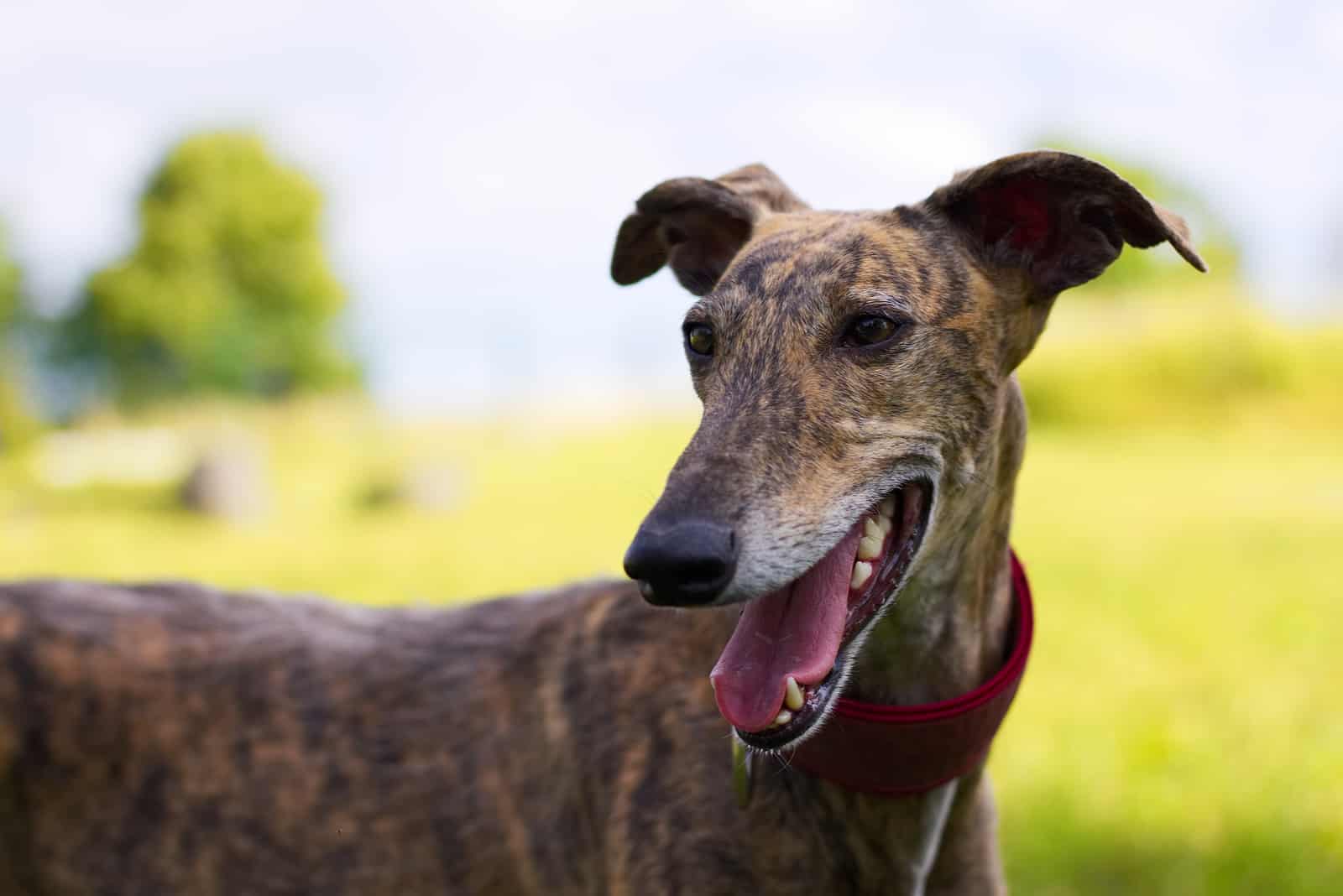
Throughout the years, rumors spread about how colors can affect a dog’s temperament. For example, while chocolate dogs were deemed more friendly, red ones were thought to be more aggressive. But, is there any truth to these stories?
So far, there has been no evidence to support the claims that a dog’s coat color can have any effect on his personality. The same goes for Greyhounds.
No matter the Greyhound color, the personality will be up to the individual dog and the training and socialization you provide your dog.
However, one thing that color can affect is the dog’s health. As mentioned before, some Greyhound colors can have a negative effect on a dog’s health.
Certain health issues, such as deafness, blindness, and heart problems, are connected with certain coat colors, such as merle.
Also, for an unknown reason, chocolate dogs are known to be more prone to various health issues. This is likely because chocolate is also the result of a dilution gene, and these genes are known to cause problems.
Other than that, you can expect your dog to behave the same no matter what coat color he has.
Can Greyhounds Change Colors?
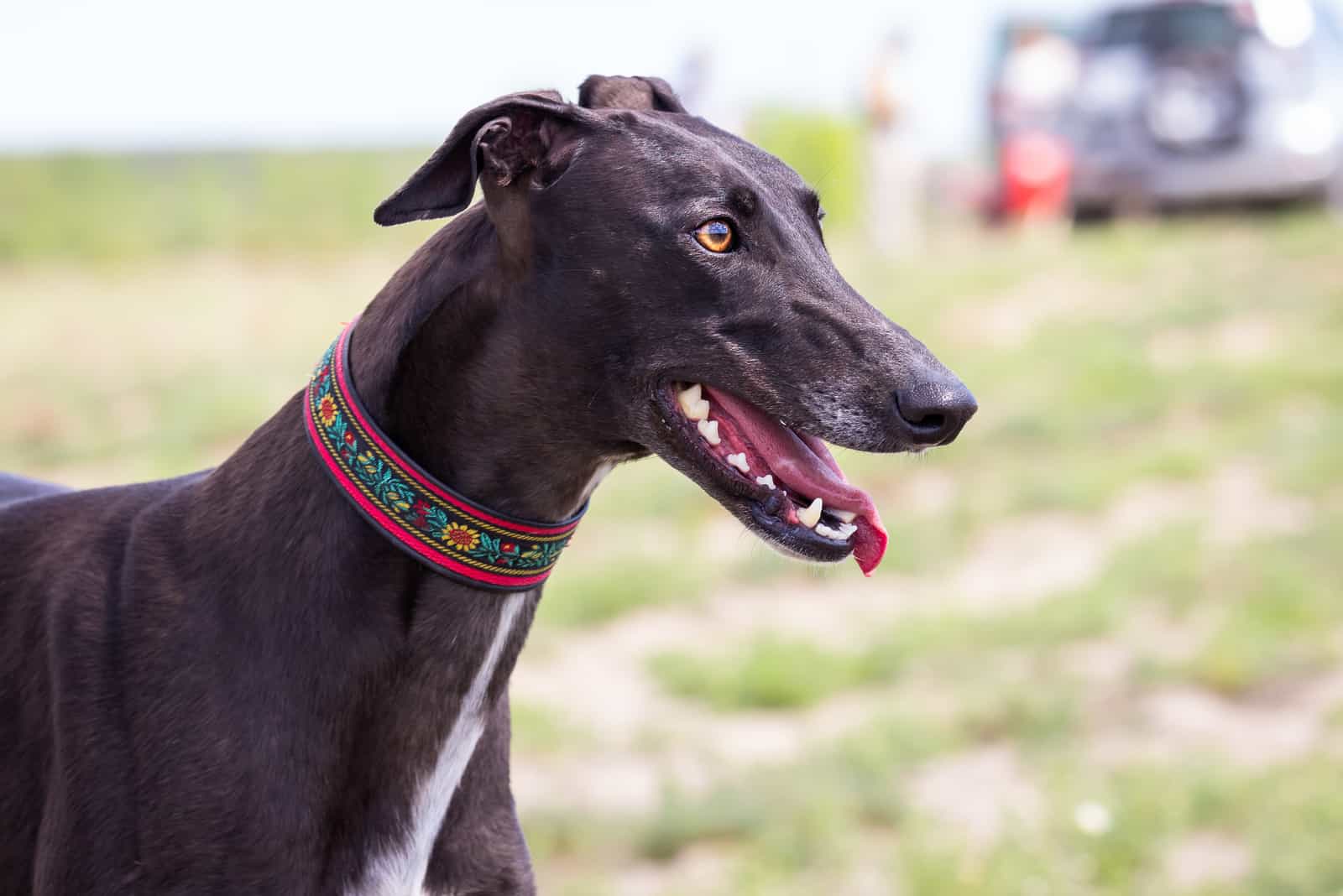
While not as prominent as in some other dog breeds, Greyhounds can experience a certain degree of coat color change. For example, black Greyhound puppies will commonly become blue or brindle when they become older.
However, most Greyhounds won’t experience any significant color change, especially once they become adults.
Due to some health problems, such as bad nutrition, a dog’s coat might appear duller in color. If you notice this happening to your Greyhound, make sure you switch to high-quality dog food. If possible, do some bloodwork. This is the only way you can rule out any underlying illnesses.
Greyhound Grooming
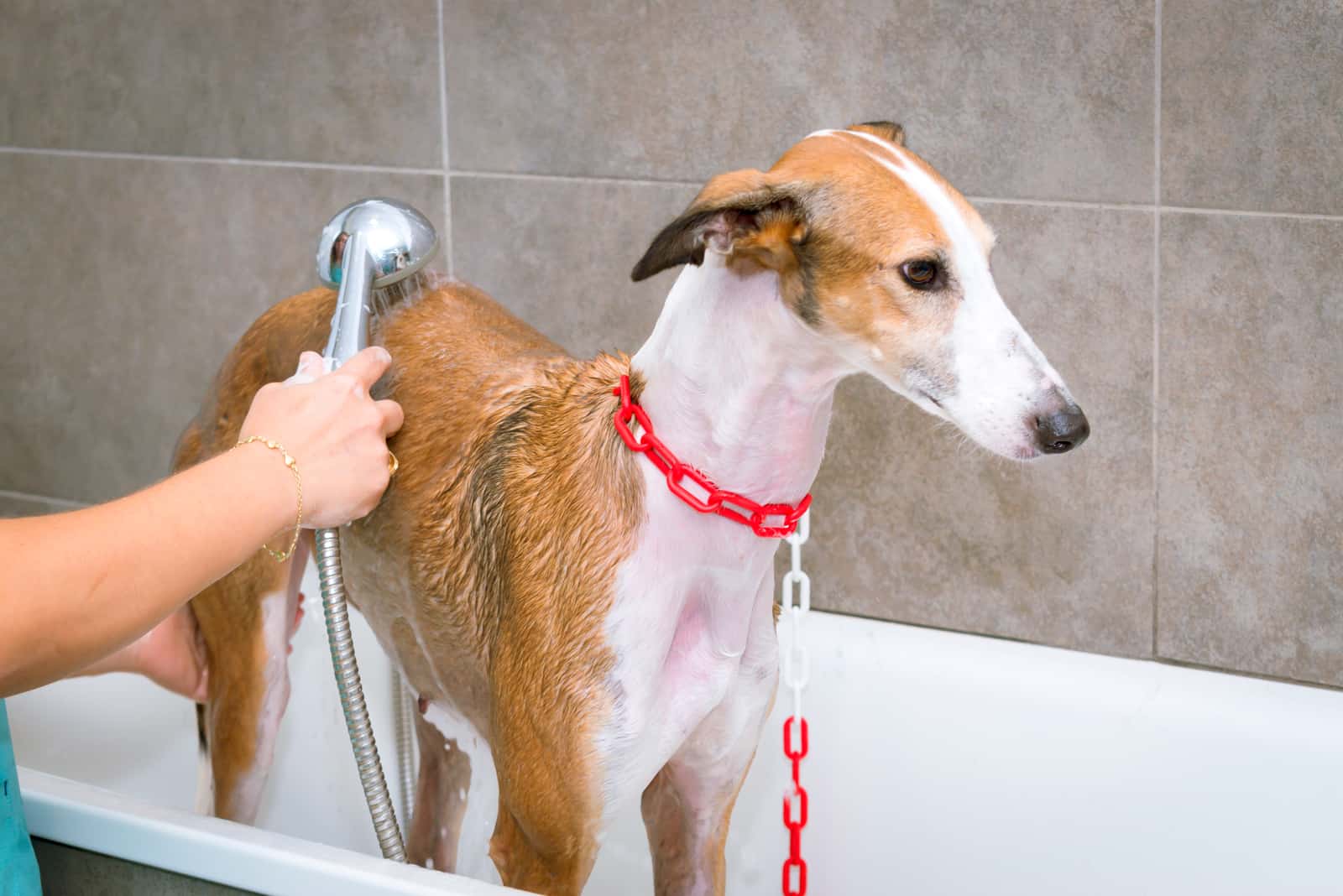
One of the reasons why Greyhounds are so loved is because they are low-maintenance dogs. In other words, they are a wash-and-go type of dog. They require very little grooming, so you don’t have to spend much time on this task.
Greyhounds have a short, slick coat, so they require little to no brushing. Also, they don’t have a lot of ‘doggy odor,’ so you don’t have to bathe them frequently. Even when they get dirty, a rubber brush, a soft brush, or a grooming mitt will be more than enough.
When you do have to bathe them, make sure to use a high-quality dog shampoo. Never bathe your pup with human shampoo, as this can cause skin irritations, and it can ruin the appearance of his fur, no matter the Greyhound colors it has.
As with most other dog breeds, you have to pay close attention to his ears, as they are prone to infection. If you notice an odor coming from your Greyhound’s ears or if he’s scratching more than usual, contact your vet and make sure he doesn’t have mites.
Trim his toenails whenever necessary. Long nails pose a health hazard – not to mention how ugly and messy they look! Also, brush his teeth and gums from time to time, as dental issues are a common problem in many dogs.
Keep in mind that Greyhounds are among the most sensitive breeds of dogs. They don’t do well with chemicals and pesticides, so most flea prevention collars will irritate them. Some contain strong substances that might even kill them!
This also means you need to watch out where you let him out for a walk. If the grass has been treated with harsh chemicals, this might poison your Greyhound. If you’ve just sprayed your backyard, don’t let your pooch outside for at least 72 hours – and try to use pet-safe substances.
Which Is The Best Color?
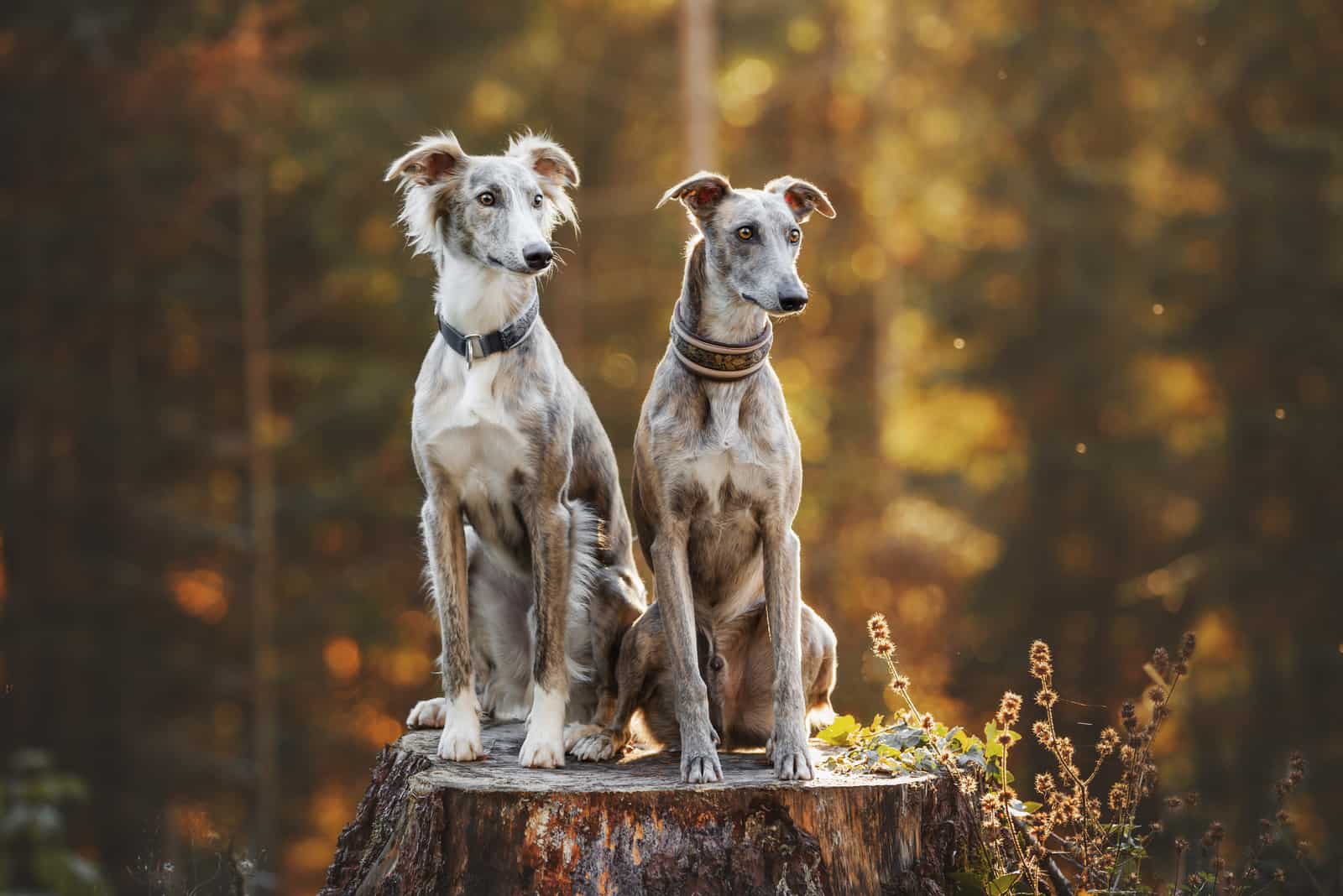
It is impossible to point out a specific Greyhound color and claim that that is the best one. What we can say is that it’s always a good idea to avoid pups with a dilution gene as you should aim to have a healthy dog with a long lifespan, but even if you pick a blue or a liver one, chances are he’ll be perfectly fine.
These sighthounds have a mild and funny personality that allows them to become everyone’s best friend. This is what made them move from the field to our homes in the first place.
The most important thing should always be to find a good breeder who conducts all the necessary health tests and who can ensure you’ll get the best dog possible. The color should always be secondary.
Of course, this doesn’t mean you aren’t allowed to like some Greyhound colors more than others and base your choice on that.
All Greyhounds make amazing pets, and you can’t go wrong by choosing this dog breed – just make sure you give him plenty of exercise and lots of love.
Read Next:
• 9 Newfoundland Colors With Pictures: Choose Your Favorite!
• It Is Not Over Until The Fat Greyhound Runs
